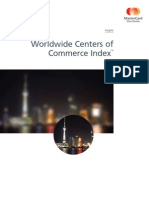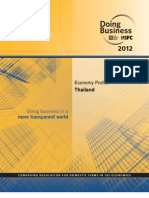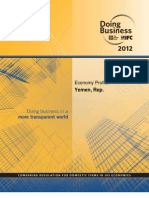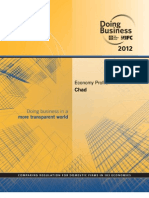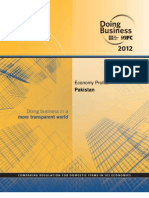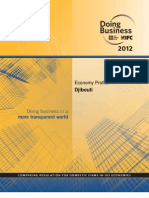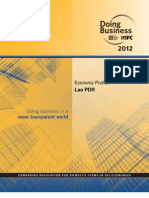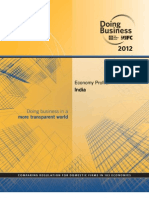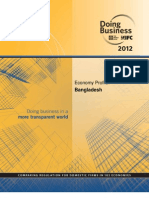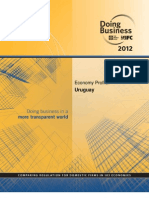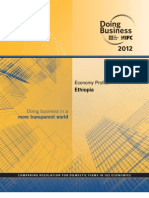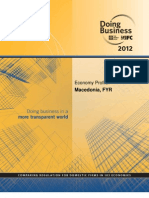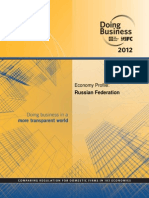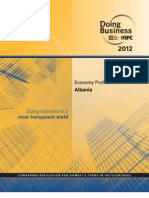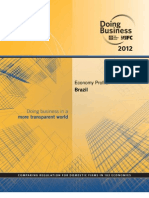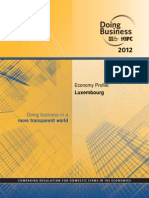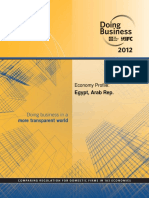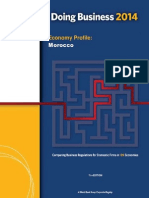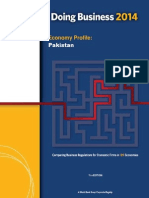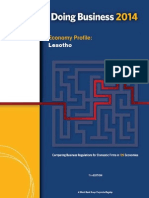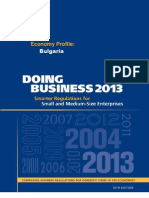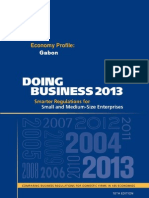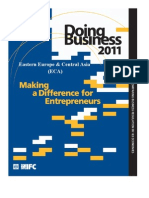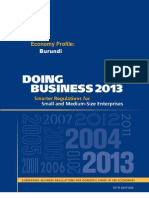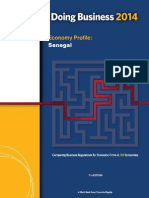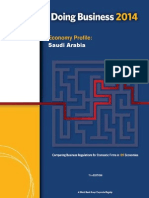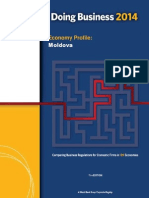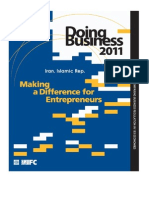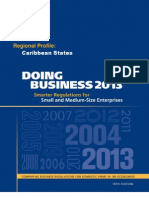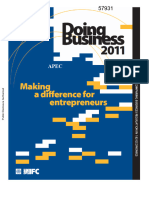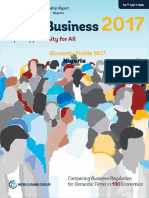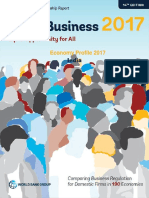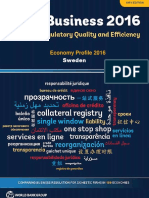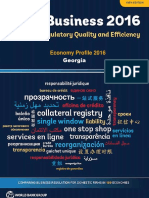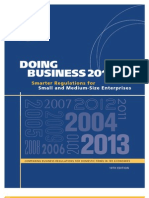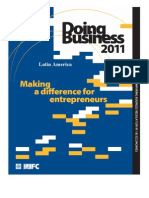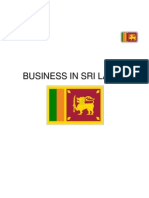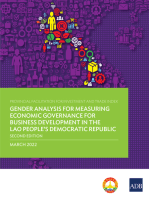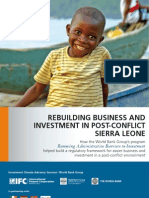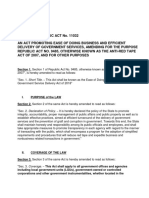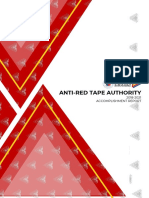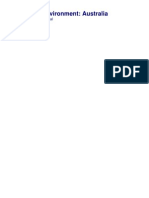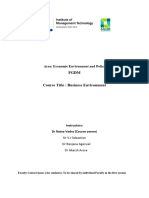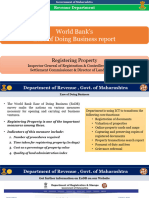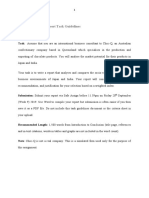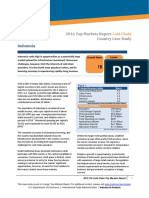Vietnam: Economy Profile
Vietnam: Economy Profile
Uploaded by
Lưu Thuý HằngCopyright:
Available Formats
Vietnam: Economy Profile
Vietnam: Economy Profile
Uploaded by
Lưu Thuý HằngOriginal Title
Copyright
Available Formats
Share this document
Did you find this document useful?
Is this content inappropriate?
Copyright:
Available Formats
Vietnam: Economy Profile
Vietnam: Economy Profile
Uploaded by
Lưu Thuý HằngCopyright:
Available Formats
Economy Profile:
Vietnam
2012 The International Bank for Reconstruction and Development / The World Bank 1818 H Street NW Washington, DC 20433 Telephone 202-473-1000 Internet www.worldbank.org
All rights reserved. 1 2 3 4 08 07 06 05 A copublication of The World Bank and the International Finance Corporation. This volume is a product of the staff of the World Bank Group. The findings, interpretations and conclusions expressed in this volume do not necessarily reflect the views of the Executive Directors of the World Bank or the governments they represent. The World Bank does not guarantee the accuracy of the data included in this work. Rights and Permissions The material in this publication is copyrighted. Copying and/or transmitting portions or all of this work without permission may be a violation of applicable law. The World Bank encourages dissemination of its work and will normally grant permission to reproduce portions of the work promptly. For permission to photocopy or reprint any part of this work, please send a request with complete information to the Copyright Clearance Center, Inc., 222 Rosewood Drive, Danvers, MA 01923, USA; telephone 978-750-8400; fax 978-750-4470; Internet www.copyright.com. All other queries on rights and licenses, including subsidiary rights, should be addressed to the Office of the Publisher, The World Bank, 1818 H Street NW, Washington, DC 20433, USA; fax 202-522-2422; e-mail pubrights@worldbank.org. Copies of Doing Business 2012: Doing Business in a More Transparent World, Doing Business 2011: Making a Difference for Entrepreneurs, Doing Business 2010: Reforming through Difficult Times, Doing Business 2009, Doing Business 2008, Doing Business 2007: How to Reform, Doing Business in 2006: Creating Jobs, Doing Business in 2005: Removing Obstacles to Growth and Doing Business in 2004: Understanding Regulations may be downloaded at www.doingbusiness.org. ISBN: 978-0-8213-8833-4 E-ISBN: 978-0-8213-8834-1 DOI: 10.1596/978-0-8213-8833-4 ISSN: 1729-2638 Printed in the United States
Doing Business 2012
Vietnam
CONTENTS
Introduction .................................................................................................................................. 4 The business environment .......................................................................................................... 5 Starting a business ..................................................................................................................... 14 Dealing with construction permits ........................................................................................... 25 Getting electricity ....................................................................................................................... 35 Registering property .................................................................................................................. 41 Getting credit .............................................................................................................................. 51 Protecting investors ................................................................................................................... 58 Paying taxes ................................................................................................................................ 68 Trading across borders .............................................................................................................. 76 Enforcing contracts .................................................................................................................... 85 Resolving insolvency .................................................................................................................. 92 Data notes ................................................................................................................................... 98 Resources on the Doing Business website ............................................................................ 103
Doing Business 2012
Vietnam
INTRODUCTION
Doing Business sheds light on how easy or difficult it is for a local entrepreneur to open and run a small to medium-size business when complying with relevant regulations. It measures and tracks changes in regulations affecting 10 areas in the life cycle of a business: starting a business, dealing with construction permits, getting electricity, registering property, getting credit, protecting investors, paying taxes, trading across borders, enforcing contracts and resolving insolvency. In a series of annual reports Doing Business presents quantitative indicators on business regulations and the protection of property rights that can be compared across 183 economies, from Afghanistan to Zimbabwe, over time. The data set covers 46 economies in SubSaharan Africa, 32 in Latin America and the Caribbean, 24 in East Asia and the Pacific, 24 in Eastern Europe and Central Asia, 18 in the Middle East and North Africa and 8 in South Asia, as well as 31 OECD highincome economies. The indicators are used to analyze economic outcomes and identify what reforms have worked, where and why. This economy profile presents the Doing Business indicators for Vietnam. To allow useful comparison, it also provides data for other selected economies (comparator economies) for each indicator. The data in this report are current as of June 1, 2011 (except for the paying taxes indicators, which cover the period JanuaryDecember 2010). The Doing Business methodology has limitations. Other areas important to businesssuch as an economys proximity to large markets, the quality of its infrastructure services (other than those related to trading across borders and getting electricity), the security of property from theft and looting, the transparency of government procurement, macroeconomic conditions or the underlying strength of institutionsare not directly studied by Doing Business. The indicators refer to a specific type of business, generally a local limited liability company operating in the largest business city. Because standard assumptions are used in the data collection, comparisons and benchmarks are valid across economies. The data not only highlight the extent of obstacles to doing business; they also help identify the source of those obstacles, supporting policy makers in designing regulatory reform. More information is available in the full report. Doing Business 2012 presents the indicators, analyzes their relationship with economic outcomes and recommends regulatory reforms. The data, along with information on ordering Doing Business 2012, are available on the Doing Business website at http://www.doingbusiness.org.
Doing Business 2012
Vietnam
THE BUSINESS ENVIRONMENT
For policy makers trying to improve their economys regulatory environment for business, a good place to start is to find out how it compares with the regulatory environment in other economies. Doing Business provides an aggregate ranking on the ease of doing business based on indicator sets that measure and benchmark regulations applying to domestic small to medium-size businesses through their life cycle. Economies are ranked from 1 to 183 by the ease of doing business index. For each economy the index is calculated as the ranking on the simple average of its percentile rankings on each of the 10 topics included in the index in Doing Business 2012: starting a business, dealing with construction permits, getting electricity, registering property, getting credit, protecting investors, paying taxes, trading across borders, enforcing contracts and resolving insolvency. The ranking on each topic is the simple average of the percentile rankings on its component indicators (see 1 the data notes for more details). The aggregate ranking on the ease of doing business benchmarks each economys performance on the indicators against that of all other economies in the Doing Business sample (figure 1.1). While this ranking tells much about the business environment in an economy, it does not tell the whole story. The ranking on the ease of doing business, and the underlying indicators, do not measure all aspects of the business environment that matter to firms and investors or that affect the competitiveness of the economy. Still, a high ranking does mean that the government has created a regulatory environment conducive to operating a business.
ECONOMY OVERVIEW
Region: East Asia & Pacific Income category: Lower middle income Population: 88,361,983 GNI per capita (US$): 1,100.00 DB2012 rank: 98 DB2011 rank: 90 Change in rank: -8 Note: See the data notes for sources and definitions.
Except for the ease of getting credit, for which the percentile rankings on its component indicators are weighted, the depth of credit information index at 37.5% and the strength of legal rights index at 62.5%.
Doing Business 2012
Vietnam
THE BUSINESS ENVIRONMENT
Figure 1.1 Where economies stand in the global ranking on the ease of doing business
Source: Doing Business database.
Doing Business 2012
Vietnam
THE BUSINESS ENVIRONMENT
For policy makers, knowing where their economy stands in the aggregate ranking on the ease of doing business is useful. Also useful is to know how it ranks compared with other economies and compared with the regional average (figure 1.2). The economys rankings on the topics included in the ease of doing business index provide another perspective (figure 1.3).
Figure 1.2 How Vietnam and comparator economies rank on the ease of doing business
Source: Doing Business database.
Doing Business 2012
Vietnam
THE BUSINESS ENVIRONMENT
Figure 1.3 How Vietnam ranks on Doing Business topics
Source: Doing Business database.
Doing Business 2012
Vietnam
THE BUSINESS ENVIRONMENT
Just as the overall ranking on the ease of doing business tells only part of the story, so do changes in that ranking. Yearly movements in rankings can provide some indication of changes in an economys regulatory environment for firms, but they are always relative. An economys ranking might change because of developments in other economies. An economy that implemented business regulation reforms may fail to rise in the rankings (or may even drop) if it is passed by others whose business regulation reforms had a more significant impact as measured by Doing Business. Moreover, year-to-year changes in the overall rankings do not reflect how the business regulatory environment in an economy has changed over time or how it has changed in different areas. To aid in assessing such changes, Doing Business 2012 introduces the distance to frontier measure. This measure shows the distance of each economy to the frontier, a synthetic measure based on the most efficient practice or highest score observed for each Doing Business indicator across all economies and years included in the Doing Business sample since 2005. Nine areas of business regulation are covered. Comparing the measure for an economy at 2 points in time allows users to assess how much the economys regulatory environment as measured by Doing Business has changed over timehow far it has moved toward (or away from) the most efficient practices and strongest regulations in areas covered by Doing Business (figure 1.4). The results may show that the pace of change varies widely across the areas measured. They also may show that an economy is relatively close to the frontier in some areas and relatively far from it in others.
Figure 1.4 How far has Vietnam come in the areas measured by Doing Business? Distance to frontier, 2005 and 2011
Note: For economies added to the Doing Business sample after 2005, the starting point is the year in which they were added: 2006 for Montenegro; 2007 for Brunei Darussalam, Liberia and Luxembourg; 2008 for The Bahamas, Bahrain and Qatar; and 2009 for Cyprus and Kosovo. See the data notes for more details on the distance to frontier measure. Source: Doing Business database.
Doing Business 2012
Vietnam
10
THE BUSINESS ENVIRONMENT
The absolute values of the indicators tell another part of the story (table 1.1). The indicators, on their own or in comparison with the indicators of a good practice economy or those of comparator economies in the region, may reveal bottlenecks reflected in large numbers of procedures, long delays or high costs. Or they may reveal unexpected strengths in an area of business regulationsuch as a regulatory process that can be completed with a small number of procedures in a few days and at a low cost. Comparison of the economys indicators today with those in the previous year may show where substantial bottlenecks persist and where they are diminishing.
Table 1.1 Summary of Doing Business indicators for Vietnam
Indicator
Starting a Business (rank) Procedures (number) Time (days) Cost (% of income per capita) Paid-in Min. Capital (% of income per capita) Dealing with Construction Permits (rank) Procedures (number) Time (days) Cost (% of income per capita)
103
100
155
89
50
158
78
157
New Zealand (1)
9 44 10.6
9 44 12.1
8 45 17.9
7 93 7.6
4 6 16.4
15 35 19.1
5 29 6.2
10 103 4.5
Canada (1)* New Zealand (1) Denmark (0.0)*
0.0
0.0
46.6
0.0
0.0
5.2
0.0
227.3
82 Economies (0.0)*
67
70
71
80
113
102
14
114
Hong Kong SAR, China (1) Denmark (5) Singapore (26)* Qatar (1.1)
10 200 109.0
10 200 124.7
13 158 105.3
23 108 52.4
22 260 7.1
30 85 110.5
8 157 9.5
19 238 25.0
Best performer globally DB2012
Timor-Leste DB2012
Philippines DB2012
Indonesia DB2012
Malaysia DB2012
Thailand DB2012
Lao PDR DB2012
Vietnam DB2012
Vietnam DB2011
Doing Business 2012
Vietnam
11
Indicator
Getting Electricity (rank) Procedures (number) Time (days) Cost (% of income per capita) Registering Property (rank) Procedures (number)
135 5 142 1343.0
135 5 142 1536.0
161 7 108 1379.0
138 5 134 2381.6
59 6 51 95.5
54 5 50 762.0
9 4 35 77.6
55 3 63 1818.2
Iceland (1) Germany (3)* Germany (17) Japan (0.0)
47
43
99
72
59
117
28
183 no practice no practice no practice 159 2
New Zealand (3)
Portugal (1)*
Time (days) Cost (% of property value) Getting Credit (rank) Strength of legal rights index (0-10) Depth of credit information index (0-6) Public registry coverage (% of adults) Private bureau coverage (% of adults) Protecting Investors (rank)
57
57
22
98
48
39
Portugal (1)
0.6 24 8
0.6 21 8
10.8 126 3
1.1 166 4
3.3 1 10
4.8 126 4
6.3 67 5
Slovak Republic (0.0) United Kingdom (1)* New Zealand (10)*
Japan (6)*
29.8
26.4
31.8
0.0
49.4
0.0
0.0
1.8
Portugal (86.2)
0.0
0.0
0.0
0.0
83.4
8.2
41.7
0.0
New Zealand (100.0)*
166
172
46
182
133
13
133
New Zealand (1)
Best performer globally DB2012
Timor-Leste DB2012
Philippines DB2012
Indonesia DB2012
Malaysia DB2012
Thailand DB2012
Lao PDR DB2012
Vietnam DB2012
Vietnam DB2011
Doing Business 2012
Vietnam
12
Indicator
Extent of disclosure index (0-10) Extent of director liability index (0-10) Ease of shareholder suits index (0-10) Strength of investor protection index (0-10) Paying Taxes (rank) Payments (number per year) Time (hours per year) Trading Across Borders (rank) Documents to export (number) Time to export (days) Cost to export (US$ per container) Documents to import (number) Time to import (days) Cost to import (US$ per container)
10
10
10
France (10)*
Singapore (9)*
New Zealand (10)*
3.0
2.7
6.0
1.7
8.7
4.0
7.7
4.0
New Zealand (9.7)
151 32 941 68
129 32 941 65
131 51 266 39
123 34 362 168
41 13 133 29
136 47 195 51
100 23 264 17
31 6 276 89
Canada (8) Norway (4) Luxembourg (59) Singapore (1)
France (2) Hong Kong SAR, China (5)* Malaysia (450)
22
22
17
44
17
15
14
25
580
555
644
1880
450
630
625
1010
8 21 670
8 21 645
7 27 660
10 46 2035
7 14 435
8 14 730
5 13 750
7 26 1015
France (2) Singapore (4) Malaysia (435)
Best performer globally DB2012
Timor-Leste DB2012
Philippines DB2012
Indonesia DB2012
Malaysia DB2012
Thailand DB2012
Lao PDR DB2012
Vietnam DB2012
Vietnam DB2011
Doing Business 2012
Vietnam
13
Indicator
Enforcing Contracts (rank) Time (days) Cost (% of claim) Procedures (number) Resolving Insolvency (rank) Time (years)
30 295 28.5 34 142
31 295 28.5 34 130
156 570 122.7 40 146
110 443 31.6 42 183 no practice no practice 0.0
31 425 27.5 29 47
112 842 26.0 37 163
24 479 12.3 36 51
183 1285 163.2 51 183 no practice no practice 0.0
Luxembourg (1) Singapore (150) Bhutan (0.1) Ireland (21)* Japan (1)
5.0
5.0
5.5
1.5
5.7
2.7
Ireland (0.4)
Cost (% of estate) Recovery rate (cents on the dollar)
15
15
18
15
38
36
Singapore (1)*
16.5
18.6
13.8
44.6
4.7
43.3
Japan (92.7)
Note: The methodology for the paying taxes indicators changed in Doing Business 2012; see the data notes for details. For these indicators, the best performer globally is the economy that has implemented the most efficient practices in its tax system and is
not necessarily the one with the highest ranking. For more information on no practice marks, see the data notes for details.
* Two or more economies share the top ranking on this indicator. A number shown in place of an economys name indicates the number of economies that share the top ranking on the indicator. For a list of these economies, see the Doing Business website (http://www.doingbusiness.org). Source: Doing Business database.
Best performer globally DB2012
Timor-Leste DB2012
Philippines DB2012
Indonesia DB2012
Malaysia DB2012
Thailand DB2012
Lao PDR DB2012
Vietnam DB2012
Vietnam DB2011
Doing Business 2012
Vietnam
14
STARTING A BUSINESS
Formal registration of companies has many immediate benefits for the companies and for business owners and employees. Legal entities can outlive their founders. Resources are pooled as several shareholders join forces to start a company. Formally registered companies have access to services and institutions from courts to banks as well as to new markets. And their employees can benefit from protections provided by the law. An additional benefit comes with limited liability companies. These limit the financial liability of company owners to their investments, so personal assets of the owners are not put at risk. Where governments make registration easy, more entrepreneurs start businesses in the formal sector, creating more good jobs and generating more revenue for the government. What do the indicators cover? Doing Business measures the ease of starting a business in an economy by recording all procedures that are officially required or commonly done in practice by an entrepreneur to start up and formally operate an industrial or commercial businessas well as the time and cost required to complete these procedures. It also records the paid-in minimum capital that companies must deposit before registration (or within 3 months). The ranking on the ease of starting a business is the simple average of the percentile rankings on the 4 component indicators: procedures, time, cost and paid-in minimum capital requirement. To make the data comparable across economies, Doing Business uses several assumptions about the business and the procedures. It assumes that all information is readily available to the entrepreneur and that there has been no prior contact with officials. It also assumes that all government and nongovernment entities involved in the process function without corruption. And it assumes that the business: Is a limited liability company, located in the largest business city. Conducts general commercial or industrial activities. WHAT THE STARTING A BUSINESS INDICATORS MEASURE Procedures to legally start and operate a company (number) Preregistration (for example, name verification or reservation, notarization) Registration in the economys largest business city Postregistration (for example, social security registration, company seal) Time required to complete each procedure (calendar days) Does not include time spent gathering information Each procedure starts on a separate day Procedure completed once final document is received No prior contact with officials Cost required to complete each procedure (% of income per capita) Official costs only, no bribes No professional fees unless services required by law Paid-in minimum capital (% of income per capita) Deposited in a bank or with a notary before registration (or within 3 months) Has a start-up capital of 10 times income per capita. Has a turnover of at least 100 times income per capita. Does not qualify for any special benefits. Does not own real estate. Is 100% domestically owned.
Doing Business 2012
Vietnam
15
STARTING A BUSINESS Where does the economy stand today?
What does it take to start a business in Vietnam? According to data collected by Doing Business, starting a business there requires 9 procedures, takes 44 days, Figure 2.1 What it takes to start a business in Vietnam Paid-in minimum capital (% of income per capita): 0.0 costs 10.6% of income per capita and requires paid-in minimum capital of 0.0% of income per capita (figure 2.1).
Note: For details on the procedures reflected here, see the summary at the end of this chapter. Source: Doing Business database.
Doing Business 2012
Vietnam
16
STARTING A BUSINESS
Globally, Vietnam stands at 103 in the ranking of 183 economies on the ease of starting a business (figure 2.2). The rankings for comparator economies and the regional average ranking provide other useful information for assessing how easy it is for an entrepreneur in Vietnam to start a business.
Figure 2.2 How Vietnam and comparator economies rank on the ease of starting a business
Source: Doing Business database.
Doing Business 2012
Vietnam
17
STARTING A BUSINESS What are the changes over time?
While the most recent Doing Business data reflect how easy (or difficult) it is to start a business in Vietnam today, data over time show which aspects of the process have changedand which have not (table 2.1). That can help identify where the potential for improvement is greatest.
Table 2.1 The ease of starting a business in Vietnam over time By Doing Business report year
Indicator Rank Procedures (number) Time (days) Cost (% of income per capita) Paid-in Min. Capital (% of income per capita)
DB2004 DB2005 DB2006 DB2007 DB2008 DB2009 DB2010 DB2011 DB2012 .. 12 63 31.9 0.0 .. 11 56 30.6 0.0 .. 11 50 27.6 0.0 .. 11 50 24.3 0.0 .. 11 50 20.0 0.0 .. 11 50 16.8 0.0 .. 11 50 13.3 0.0 100 9 44 12.1 0.0 103 9 44 10.6 0.0
Note: n.a. = not applicable (the economy was not included in Doing Business for that year). DB2012 rankings reflect changes to the methodology. Source: Doing Business database.
Doing Business 2012
Vietnam
18
STARTING A BUSINESS
Equally helpful may be the benchmarks provided by the economies that today have the best performance regionally or globally on the procedures, time, cost or paid-in minimum capital required to start a business (figure 2.3). These economies may provide a model for Vietnam on ways to improve the ease of starting a business. And changes in regional averages can show where Vietnam is keeping upand where it is falling behind.
Figure 2.3 Has starting a business become easier over time? Procedures (number)
Time (days)
Doing Business 2012
Vietnam
19
STARTING A BUSINESS
Cost (% of income per capita)
Paid-in minimum capital (% of income per capita)
Note: The economy with the best performance regionally on each indicator, and the economy with the best performance globally, are included as benchmarks. In some cases 2 or more economies share the top regional or global ranking on an indicator. In the case of paid-in minimum capital, 82 economies globally and 14 economies in East Asia & Pacific have no paid-in minimum capital. Source: Doing Business database.
Doing Business 2012
Vietnam
20
STARTING A BUSINESS
Economies around the world have taken steps making it easier to start a businessstreamlining procedures by setting up a one-stop shop, making procedures simpler or faster by introducing technology and reducing or eliminating minimum capital requirements. Many have undertaken business registration reforms in stagesand they often are part of a larger regulatory reform program. Among the benefits have been greater firm satisfaction and savings and more registered businesses, financial resources and job opportunities. What business registration reforms has Doing Business recorded in Vietnam (table 2.2)?
Table 2.2 How has Vietnam made starting a business easieror not? By Doing Business report year
DB Year DB2012
Reform No reform. Vietnam eased company start-up by creating a one-stop shop that combines the processes for obtaining a business license and tax license and by eliminating the need for a seal for company licensing. No reform. No reform.
DB2011
DB2010 DB2009
Note: For information on reforms in earlier years (back to DB2005), see the Doing Business reports for these years, available at http://www.doingbusiness.org. Source: Doing Business database.
Doing Business 2012
Vietnam
21
STARTING A BUSINESS What are the details?
Underlying the indicators shown in this chapter for Vietnam is a set of specific proceduresthe bureaucratic and legal steps that an entrepreneur must complete to incorporate and register a new firm. These are identified by Doing Business through collaboration with relevant local professionals and the study of laws, regulations and publicly available information on business entry in that economy. Following is a detailed summary of those procedures, along with the associated time and cost. These procedures are those that apply to a company matching the standard assumptions (the standardized company) used by Doing Business in collecting the data (see the section in this chapter on what the indicators measure). STANDARDIZED COMPANY City: Ho Chi Minh City Legal Form: Cong ty trach nhiem huu han - Private Limited Liability Company Start-up capital: 10 times GNI per capita Paid-in minimum capital (% of income per capita): 0.0
Summary of procedures for starting a business in Vietnamand the time and cost
No. Procedure Check the proposed company name; obtain a business registration certificate as well as a tax registration certificate from the local business registration office under the Department of Planning and Investment The applicant has to submit documents stipulated in article 15 of Decree 88 and also a Declaration of Tax Information in the prescribed format set out in the Joint Circular and in that case, the business registration office of the Department of Planning & Investment will issue a Business and Tax Registration Certificate to the enterprise. Forms can now be downloaded, and the application can be submitted online. The Business Registry Office must verify the online application for completeness and correctness and reply via email within 5 days from the day of the received application. If the application must be revised, the Business Registry Office must reply once again within a day of application revision. The registrant must submit the original application and related documents within 10 days of submitting the correct online application and must receive the license on the same day. Make a company seal 2 Registration of the sea-sample at the Police Department 3 Most business transaction documents must be signed and stamped before they are considered valid and legal. The fee for the seals 4 days VND 20,000 Time to complete Cost to complete
14 days
VND 200,000 (official fees) + VND 1,000,000 (business license tax)
6 days
VND 165,000 - VND 370,000 for bronze seal
Doing Business 2012
Vietnam
22
No.
Procedure certificate of registration is VND 20,000. The seal will be registered by the police division. The representative has to lodge a copy of the Business and Tax Registration Certificate and also present his or her identity card. Open a bank account Each bank requires a different minimum deposit to open an account. For instance, whereas Vietcombank requires the fixed amount of VND 5 million for an account in VND and USD 500 for one in USD, Asian Commercial Bank requires VND 1 million for a VND account and US 100 for a USD account. To open the account, the bank requires a bankissued application form, the company seal, the companys business registration certificate, and the resolution of the management board on the authorized signatures. Publish announcement in a daily newspaper
Time to complete
Cost to complete
1 day
no charge
5 Buy pre-printed VAT invoices from the Municipal Taxation Department or obtain and print self-printed VAT invoices To obtain VAT invoices, company founders must submit the following documents to the Municipal Tax Department: - Managing directors delegation of authority to the procurement agent (contact the Tax Department to buy invoices). - Application for buying preprinted invoices (standard form available). - Identify card of the procurement agent. - Business registration certificate and copy. - Tax registration certificate and copy. After receiving the companys completed application, the Municipal Tax Department schedules an appointment for invoice purchase within 5 days. During this 5-day period, a tax officer visits the companys office to certify its existence and issue the company a certification of the company office location. Note that the first purchase is restricted to not more than two books (100 copies). To register for self-printing of invoices, company founders must submit an application on a standard form, along with (a) a sample self-printed invoice, including all statutory details; (b) a map showing the location of the companys office or copy of the lease contract if the premises are leased, certified by the ward commune peoples committee; (c) the general directors identification card; (d) a copy of the business registration certificate; and (e) and the tax registration certificate and copy. It may take 710 days to register the self-printed invoices with the Municipal Taxation Department, and more time for the company to self-print the invoices. It may take 715 days for printing the invoices at a printer authorized by the General Taxation Department of Vietnam. After having the
5 days
VND 700,000
14 days
If buying the preprinted VAT Invoices: VND 20,000 per book (50 copies)
Doing Business 2012
Vietnam
23
No.
Procedure invoices printed and before using them, the company must register the invoice serial numbers with the Municipal Taxation Department. * Register with the local labor office to declare use of labor (Municipal Department for Labor, Invalids and Social Affairs).
Time to complete
Cost to complete
Within 30 days of starting operations, the employer must register all employees and their qualifications with the Labor Office (in conformity with set forms). The relationship between the employer and its employees are regulated by the Labor Code and set forth in labor contracts. Register employees with the Social Insurance Fund for the payment of health insurance and social insurance. The company must register with the Social Insurance Fund all employees who have contracts for 3 months or longer. The employer must complete a form provided by the Hanoi Social Insurance and include the following information: the employee name and date of birth, salary (as stated in the labor contract), the social insurance book serial number (for employees already issued with those books), a certified copy of the company's business registration certificate, and a copy of each labor contract. The Social Insurance Office will issue an insurance registration book for each new employee that was not issued such book by the previous employer. The employer is responsible for paying social and health insurance contributions for each employee. Since the health insurance merged with the social insurance funds, payment is made (monthly or quarterly) directly to the Social Insurance Fund. Health insurance certificates are issued during the first month of the year. * Register for trade union with Vietnam General Confederation of Labour The employer must register with the local trade union or industry trade union (as defined below) no later than 6 months from the date it starts operations. The term trade union includes (a) provincial or municipal-level confederations of labor under the Vietnam General Confederation of Labour; (b) central-level industry trade unions; (c) trade unions of corporations under the Vietnam General Confederation of Labor; (d) confederations of labor of districts, towns, and provincial cities; (e) local-level industry trade unions, (f) trade unions of processing zones, industrial zones, and high-tech zones; (f) trade unions of corporations; and (g) superior trade unions of other establishments. These trade unions are responsible for establishing a trade union for the company, according to the provisions of the Labour Code, the Law on Trade Unions, and the Charter of the Trade Union of Vietnam, to represent and protect the lawful and legitimate rights and interests of the employees and the labor collective. If a company trade union is not established within 6 months, the
1 day (simultaneous with previous procedure)
no charge
1 day (simultaneous with previous procedure)
no charge
7 days (simultaneous with previous procedure)
no charge
Doing Business 2012
Vietnam
24
No.
Procedure superior trade union shall appoint a provisional executive committee of the trade union to represent and protect the lawful and legitimate rights and interests of the employees and the labor collective. This mandate is provided for by the Labour Code, the Law on Trade Unions, and the Charter of the Trade Union of Vietnam. The term of the provisional executive committee of the trade union and the extension of that term is subject to the regulations of the Vietnam General Confederation of Labor.
Time to complete
Cost to complete
* Takes place simultaneously with another procedure. Source: Doing Business database.
Doing Business 2012
Vietnam
25
DEALING WITH CONSTRUCTION PERMITS
Regulation of construction is critical to protect the public. But it needs to be efficient, to avoid excessive constraints on a sector that plays an important part in every economy. Where complying with building regulations is excessively costly in time and money, many builders opt out. They may pay bribes to pass inspections or simply build illegally, leading to hazardous construction that puts public safety at risk. Where compliance is simple, straightforward and inexpensive, everyone is better off. What do the indicators cover? Doing Business records the procedures, time and cost for a business to obtain all the necessary approvals to build a simple commercial warehouse in the economys largest business city, connect it to basic utilities and register the property so that it can be used as collateral or transferred to another entity. The ranking on the ease of dealing with construction permits is the simple average of the percentile rankings on its component indicators: procedures, time and cost. To make the data comparable across economies, Doing Business uses several assumptions about the business and the warehouse, including the utility connections. The business: Is a limited liability company operating in the construction business and located in the largest business city. Is domestically owned and operated. Has 60 builders and other employees. WHAT THE DEALING WITH CONSTRUCTION PERMITS INDICATORS MEASURE Procedures to legally build a warehouse (number) Submitting all relevant documents and obtaining all necessary clearances, licenses, permits and certificates Completing all required notifications and receiving all necessary inspections Obtaining utility connections for water, sewerage and a fixed telephone line Registering the warehouse after its completion (if required for use as collateral or for transfer of the warehouse) Time required to complete each procedure (calendar days) Does not include time spent gathering information Each procedure starts on a separate day Procedure completed once final document is received No prior contact with officials Cost required to complete each procedure (% of income per capita) Official costs only, no bribes Will be connected to water, sewerage (sewage system, septic tank or their equivalent) and a fixed telephone line. The connection to each utility network will be 10 meters (32 feet, 10 inches) long. Will be used for general storage, such as of books or stationery (not for goods requiring special conditions). Will take 30 weeks to construct (excluding all delays due to administrative and regulatory requirements).
The warehouse: Is a new construction (there was no previous construction on the land). Has complete architectural and technical plans prepared by a licensed architect.
Doing Business 2012
Vietnam
26
DEALING WITH CONSTRUCTION PERMITS Where does the economy stand today?
What does it take to comply with the formalities to build a warehouse in Vietnam? According to data collected by Doing Business, dealing with construction permits there requires 10 procedures, takes 200 days and costs 109.0% of income per capita (figure 3.1).
Figure 3.1 What it takes to comply with formalities to build a warehouse in Vietnam
Note: For details on the procedures reflected here, see the summary at the end of this chapter. Source: Doing Business database.
Doing Business 2012
Vietnam
27
DEALING WITH CONSTRUCTION PERMITS
Globally, Vietnam stands at 67 in the ranking of 183 economies on the ease of dealing with construction permits (figure 3.2). The rankings for comparator economies and the regional average ranking provide other useful information for assessing how easy it is for an entrepreneur in Vietnam to legally build a warehouse.
Figure 3.2 How Vietnam and comparator economies rank on the ease of dealing with construction permits
Source: Doing Business database.
Doing Business 2012
Vietnam
28
DEALING WITH CONSTRUCTION PERMITS What are the changes over time?
While the most recent Doing Business data reflect how easy (or difficult) it is to deal with construction permits in Vietnam today, data over time show which aspects of the process have changedand which have not (table 3.1). That can help identify where the potential for improvement is greatest.
Table 3.1 The ease of dealing with construction permits in Vietnam over time By Doing Business report year Indicator Rank Procedures (number) Time (days) Cost (% of income per capita) DB2006 .. 10 200 466.1 DB2007 .. 10 200 410.0 DB2008 .. 10 200 367.4 DB2009 .. 10 200 308.1 DB2010 .. 10 200 244.0 DB2011 70 10 200 124.7 DB2012 67 10 200 109.0
Note: n.a. = not applicable (the economy was not included in Doing Business for that year). DB2012 rankings reflect changes to the methodology. For more information on no practice marks, see the data notes for details. Source: Doing Business database.
Doing Business 2012
Vietnam
29
DEALING WITH CONSTRUCTION PERMITS
Equally helpful may be the benchmarks provided by the economies that today have the best performance regionally or globally on the procedures, time or cost required to deal with construction permits (figure 3.3). These economies may provide a model for Vietnam on ways to improve the ease of dealing with construction permits. And changes in regional averages can show where Vietnam is keeping upand where it is falling behind.
Figure 3.3 Has dealing with construction permits become easier over time? Procedures (number)
Time (days)
Doing Business 2012
Vietnam
30
DEALING WITH CONSTRUCTION PERMITS
Cost (% of income per capita)
Note: The economy with the best performance regionally on each indicator, and the economy with the best performance globally, are included as benchmarks. In some cases 2 or more economies share the top regional or global ranking on an indicator. In cases where no data are displayed above for the economy, this indicates that the economy has received a
no practice mark; see the data notes for details.
Source: Doing Business database.
Doing Business 2012
Vietnam
31
DEALING WITH CONSTRUCTION PERMITS
Smart regulation ensures that standards are met while making compliance easy and accessible to all. Coherent and transparent rules, efficient processes and adequate allocation of resources are especially important in sectors where safety is at stake. Construction is one of them. In an effort to ensure building safety while keeping compliance costs reasonable, governments around the world have worked on consolidating permitting requirements. What construction permitting reforms has Doing Business recorded in Vietnam (table 3.2)?
Table 3.2 How has Vietnam made dealing with construction permits easieror not? By Doing Business report year DB Year Reform
DB2012
No reform.
DB2011
Vietnam made dealing with construction permits easier by reducing the cost to register newly completed buildings by 50% and transferring the authority to register buildings from local authorities to the Department of National Resources and Environment.
DB2010
No reform.
DB2009
No reform.
Note: For information on reforms in earlier years (back to DB2006), see the Doing Business reports for these years, available at http://www.doingbusiness.org. Source: Doing Business database.
Doing Business 2012
Vietnam
32
DEALING WITH CONSTRUCTION PERMITS What are the details?
The indicators reported here for Vietnam are based on a set of specific proceduresthe steps that a company must complete to legally build a warehouseidentified by Doing Business through information collected from experts in construction licensing, including architects, construction lawyers, construction firms, utility service providers and public officials who deal with building regulations. These procedures are those that apply to a company and structure matching the standard assumptions used by Doing Business in collecting the data (see the section in this chapter on what the indicators cover). BUILDING A WAREHOUSE City : Estimated Warehouse Value : Ho Chi Minh City VND 3,515,000,000
The procedures, along with the associated time and cost, are summarized below.
Summary of procedures for dealing with construction permits in Vietnam and the time and cost
No. Procedure Request and obtain construction permit from the (District) Department of Construction of Ho Chi Minh City The decision to grant a construction permit is made by the Chairman of the Peoples Committee, at the provincial level, and the Director of the Department of Construction. The following documents are required: - Application letter (in the approved form). - A copy of the land use rights certificate with abstracts from the real estate registry or an outline of the construction site. Land is national property in Vietnam. Only a business could be the holder of the landuse right. It is assumed that the BuildCo already holds the land-use certificate. - Business license. - One set of construction designs. 1 If deemed necessary, the Department of Construction consults any of the following related offices: - Office of the Chief Architect. - Office for Land Planning. - Office for Land Management. - Department of Culture. - Department of Health. - Department of Natural Resources and Environment. - Fire Protection Office. - Department of Public Traffic and Transportation. - Local National Defense Office. Each consultation separately takes 10 days. However, the Department of Construction is required to abide by the overall time limit of 30 working days to issue or refuse the license. In practice, this time limit is 90 days VND 100,000 Time to complete Cost to complete
Doing Business 2012
Vietnam
33
No.
Procedure seldom met. The application form can be obtained at the local department of construction. It is currently required for a construction company to go to the office and obtain the form. Internet download is not possible yet. After obtaining a construction permit, within a time limit of 7 working days prior to the date of commencement of construction of the warehouse, BuildCo is required to provide written notification of the commencement date to the People's Committee at the district level where the warehouse is located. (See Article 68.2 (a) of the Law on Construction No. 16/2003/QH11, dated November 16, 2003.) Receive inspection by the Department of Construction of Ho Chi Minh City
Time to complete
Cost to complete
This inspection and the following ones are not stipulated by specific regulations. However, because the authority is mandated to supervise the inspections, these do take place in practice. Receive inspection from the municipality after completion of foundation works
1 day
no charge
The company must notify the Department of Construction at the different stages of construction and suspend construction until the department visits the site 3 days after the notification. Receive inspection from the municipality at completion of building surroundings
1 day
no charge
The company must notify the Department of Construction at the different stages of construction and suspend construction until the department visits the site a week after the notification. Request water and sewage connection Different areas in Ho Chi Minh City are covered by different public water companies. Therefore, BuildCo is required to contact the relevant water company and submit the following documents: - The application form (available at the water company). - A notarized copy of the business registration certificate of BuildCo. The costs of obtaining water/ sewage connection depend on the usage capacity of the warehouse, as well as on its exact location in relation to the main water lines. The standard water meters cost approximately VND 1.5 million. * Receive inspection by water company
1 day
no charge
1 day
VND 4,000,000
6 * Connect to water and sewage services 7 * Request and connect to phone line 8 The time frame for requesting and receiving telephone service depends on the district in which BuildCo is located. The cost varies between VND 545,454 and VND 727,272 (decided by the director of each provincial post office).
1 day
no charge
14 days
no charge
7 days
VND 800,000
Doing Business 2012
Vietnam
34
No.
Procedure (see http://www.vnpt.com.vn) Notify and receive inspection from the municipality after completion of building
Time to complete
Cost to complete
At the end of construction, the Department of Construction visits the site to confirm that the building was built according to the master plans, rules, and regulations. BuildCo must provide written notification of the completion of construction. Register the building at the Department of Construction of Ho Chi Minh City The cost for registering ownership of the warehouse should include an administrative fee of VND 500,000 (about USD 31.25) and a registration fee of 1% of the warehouse value. For the registration fee, the value of the construction contract signed between BuildCo and the construction contractor will be taken as the warehouse value, provided that it is higher than the minimum value calculated by the Tax Department based on the minimum unit price as provided for by the Peoples Committee of Ho Chi Minh City.
1 day
no charge
The application file should be submitted to the Department of Construction of Ho Chi Minh City. According to Decree 95/2005/ND-CP (dated July 15, 2005), On Issuance of Certificates of Ownership of Residential Houses and Construction Works, the work carried out by the Department of Construction may take 55 working days, including time for taking measurements or checking the measurements of the construction works, if any; reviewing the application file; submitting the file for approval and signature; and notifying the applicant to make payment of financial obligations (e.g., payment of the registration fee at Tax Department). Decree 95/2005/ND-CP also states that the applicant must pay all financial obligations within 60 working days from the date of receipt of the notification from the Department of Construction. * Takes place simultaneously with another procedure. Source: Doing Business database.
10
90 days
VND 17,825,000
Doing Business 2012
Vietnam
35
GETTING ELECTRICITY
Access to reliable and affordable electricity is vital for businesses. To counter weak electricity supply, many firms in developing economies have to rely on self-supply, often at a prohibitively high cost. Whether electricity is reliably available or not, the first step for a customer is always to gain access by obtaining a connection. What do the indicators cover? Doing Business records all procedures required for a local business to obtain a permanent electricity connection and supply for a standardized warehouse, as well as the time and cost to complete them. These procedures include applications and contracts with electricity utilities, clearances from other agencies and the external and final connection works. The ranking on the ease of getting electricity is the simple average of the percentile rankings on its component indicators: procedures, time and cost. To make the data comparable across economies, several assumptions are used. The warehouse: Is located in the economys largest business city, in an area where other warehouses are located. Is not in a special economic zone where the connection would be eligible for subsidization or faster service. Has road access. The connection works involve the crossing of a road or roads but are carried out on public land. Is a new construction being connected to electricity for the first time. Has 2 stories, both above ground, with a total surface of about 1,300.6 square meters (14,000 square feet), and is built on a plot of 929 square meters (10,000 square feet). WHAT THE GETTING ELECTRICITY INDICATORS MEASURE Procedures to obtain an electricity connection (number) Submitting all relevant documents and obtaining all necessary clearances and permits Completing all required notifications and receiving all necessary inspections Obtaining external installation works and possibly purchasing material for these works Concluding any necessary supply contract and obtaining final supply Time required to complete each procedure (calendar days) Is at least 1 calendar day Each procedure starts on a separate day Does not include time spent gathering information Reflects the time spent in practice, with little follow-up and no prior contact with officials Cost required to complete each procedure (% of income per capita) Official costs only, no bribes Excludes value added tax Is 150 meters long. Is to either the low-voltage or the mediumvoltage distribution network and either overhead or underground, whichever is more common in the economy and in the area where the warehouse is located. The length of any connection in the customers private domain is negligible. Involves installing one electricity meter. The monthly electricity consumption will be 0.07 gigawatt-hour (GWh). The internal electrical wiring has been completed.
The electricity connection: Is a 3-phase, 4-wire Y, 140-kilovolt-ampere (kVA) (subscribed capacity) connection.
Doing Business 2012
Vietnam
36
GETTING ELECTRICITY Where does the economy stand today?
What does it take to obtain a new electricity connection in Vietnam? According to data collected by Doing Business, getting electricity there requires 5 procedures, takes 142 days and costs 1343.0% of income per capita (figure 4.1).
Figure 4.1 What it takes to obtain an electricity connection in Vietnam
Note: For details on the procedures reflected here, see the summary at the end of this chapter. Source: Doing Business database.
Doing Business 2012
Vietnam
37
GETTING ELECTRICITY
Globally, Vietnam stands at 135 in the ranking of 183 economies on the ease of getting electricity (figure 4.2). The rankings for comparator economies and the regional average ranking provide another perspective in assessing how easy it is for an entrepreneur in Vietnam to connect a warehouse to electricity.
Figure 4.2 How Vietnam and comparator economies rank on the ease of getting electricity
Source: Doing Business database.
Doing Business 2012
Vietnam
38
GETTING ELECTRICITY
Even more helpful than rankings for other economies may be the indicators underlying those rankings (table 4.1). If obtaining a new electricity connection requires fewer procedures, less time or less cost in other economies, the practices of their utilities may provide a model for Vietnam on ways to improve the ease of getting electricity. Regional and global averages on these indicators may provide useful benchmarks.
Table 4.1 The ease of getting electricity in Vietnam and comparator economies
East Asia & Pacific average
Indicator
Rank Procedures (number) Time (days) Cost (% of income per capita)
Source: Doing Business database.
135 5 142 1343.0
161 7 108 1379.0
138 5 134 2381.6
59 6 51 95.5
54 5 50 762.0
9 4 35 77.6
55 3 63 1818.2
75 5 88
111
1,079.4 1,942.3
Global average
Timor-Leste
Philippines
Indonesia
Malaysia
Thailand
Lao PDR
Vietnam
.. 5
Doing Business 2012
Vietnam
39
GETTING ELECTRICITY What are the details?
The indicators reported here for Vietnam are based on a set of specific proceduresthe steps that an entrepreneur must complete to get a warehouse connected to electricity by the local distribution utilityidentified by Doing Business. Data are collected from the distribution utility, then completed and verified by electricity regulatory agencies and independent professionals such as electrical engineers, electrical contractors and construction companies. The electricity distribution utility surveyed is the one serving the area (or areas) in which warehouses are located. If there is a choice of distribution utilities, the one serving the largest number of customers is selected. OBTAINING AN ELECTRICITY CONNECTION City: Name of Utility:
Ho Chi Minh City
Ho Chi Minh City Power Company The procedures are those that apply to a warehouse and electricity connection matching the standard assumptions used by Doing Business in collecting the data (see the section in this chapter on what the indicators cover). The procedures, along with the associated time and cost, are summarized below.
Summary of procedures for getting electricity in Vietnamand the time and cost
No. Procedure The customer applies for electricity connection and awaits clearance from Ho Chi Minh City Power Corporation (EVN HCMC) Along with the application, the following documents are needed for requesting electricity connection: A. Request document for power supply or official dispatch sent to Distribution Department under regulation at Clause 5 of this process attached by breakdown of equipment, regulations, and capacities. For the purposes of manufacturing and business, a service having a maximum capacity of over 80kW or a transformer with a capacity beyond 100kVA, a copy of the load schedule and technical specification of the equipment must also be submitted. 30 calendar days B. There are also the following 2 categories of documents (notarized copies): B.1 The first category is related to the construction location: Ownership certificate; Certificate of land-using right; House-hiring Contract confirmed by authorized organization; Land-hiring Contract confirmed by authorized organization; and Decision of handling over house or land of Authorized organization. In case these documents are not available, one can submit a Confirmation Paper from the authorized organization or local administration when requesting power supply (not adhering to this Clause in the case of a specific construction is investigated by the utility). Time to complete Cost to complete
no charge
Doing Business 2012
Vietnam
40
No.
Procedure B.2 The other category of documents is related to the client: Business registration Certificate or Certificate of registration of branch, representative office; Investment license; and Decision of unit foundation. After the utility has received the application, it inspects the site to determine the specifics of the connection. No estimate of connection fees is prepared. However, the client needs to await approval (clearance) of Ho Chi Minh City Power Company (HCMCPC) on the requested power. * The customer obtains external inspection from Ho Chi Minh City Power Corporation (EVN HCMC)
Time to complete
Cost to complete
1 calendar day
no charge
The customer has to obtain an excavation permit for the underground connection at the Traffice and Transport Department 3 The customer has to obtain an excavation permit for the underground connection at the Traffice and Transport Department. The customer hires a private firm for the design and carrying out of the external works The customer can either ask the Distribution Department of EVN HCMC to do the works for them or hire a private firm for that. The more common approach is to hire an outside firm. If more than 100 kVA is needed, a substation must be built. In the case where the customer chooses to hire an outside agency to carry out the works, the electricity company must first approve the designs. A contract is signed after both parties have agreed on the capacity, construction schedule, construction border, etc. There is no inspection of the entire internal wiring (only a final check at the time of installing the meter), and any electrician can carry out the internal installation. To ensure liability, the customer could hire a licensed electrical construction company. The customer obtains meter installation and final connection from Ho Chi Minh City Power Corporation (EVN HCMC) 5 When the external works have been completed, the customer requests meter installation from the Distribution Department of the utility. * Takes place simultaneously with another procedure. Source: Doing Business database.
15 calendar days
no charge
90 calendar days
VND 280,000,000.0
7 calendar days
no charge
Doing Business 2012
Vietnam
41
REGISTERING PROPERTY
Ensuring formal property rights is fundamental. Effective administration of land is part of that. If formal property transfer is too costly or complicated, formal titles might go informal again. And where property is informal or poorly administered, it has little chance of being accepted as collateral for loanslimiting access to finance. What do the indicators cover? Doing Business records the full sequence of procedures necessary for a business to purchase property from another business and transfer the property title to the buyers name. The transaction is considered complete when it is opposable to third parties and when the buyer can use the property, use it as collateral for a bank loan or resell it. The ranking on the ease of registering property is the simple average of the percentile rankings on its component indicators: procedures, time and cost. To make the data comparable across economies, several assumptions about the parties to the transaction, the property and the procedures are used. The parties (buyer and seller): Are limited liability companies, 100% domestically and privately owned. Are located in the periurban area of the economys largest business city. Have 50 employees each, all of whom are nationals. Perform general commercial activities. WHAT THE REGISTERING PROPERTY INDICATORS MEASURE Procedures to legally transfer title on immovable property (number) Preregistration (for example, checking for liens, notarizing sales agreement, paying property transfer taxes) Registration in the economys largest business city Postregistration (for example, filing title with the municipality) Time required to complete each procedure (calendar days) Does not include time spent gathering information Each procedure starts on a separate day Procedure completed once final document is received No prior contact with officials Cost required to complete each procedure (% of property value) Official costs only, no bribes No value added or capital gains taxes included
Has no mortgages attached and has been under the same ownership for the past 10 years. Consists of 557.4 square meters (6,000 square feet) of land and a 10-year-old, 2-story warehouse of 929 square meters (10,000 square feet). The warehouse is in good condition and complies with all safety standards, building codes and legal requirements. The property will be transferred in its entirety.
The property (fully owned by the seller): Has a value of 50 times income per capita. The sale price equals the value. Is registered in the land registry or cadastre, or both, and is free of title disputes. Is located in a periurban commercial zone, and no rezoning is required.
Doing Business 2012
Vietnam
42
REGISTERING PROPERTY Where does the economy stand today?
What does it take to complete a property transfer in Vietnam? According to data collected by Doing Business, registering property there requires 4 Figure 5.1 What it takes to register property in Vietnam procedures, takes 57 days and costs 0.6% of the property value (figure 5.1).
Note: For details on the procedures reflected here, see the summary at the end of this chapter. Source: Doing Business database.
Doing Business 2012
Vietnam
43
REGISTERING PROPERTY
Globally, Vietnam stands at 47 in the ranking of 183 economies on the ease of registering property (figure 5.2). The rankings for comparator economies and the regional average ranking provide other useful information for assessing how easy it is for an entrepreneur in Vietnam to transfer property.
Figure 5.2 How Vietnam and comparator economies rank on the ease of registering property
Source: Doing Business database.
Doing Business 2012
Vietnam
44
REGISTERING PROPERTY What are the changes over time?
While the most recent Doing Business data reflect how easy (or difficult) it is to register property in Vietnam today, data over time show which aspects of the process have changedand which have not (table 5.1). That can help identify where the potential for improvement is greatest.
Table 5.1 The ease of registering property in Vietnam over time By Doing Business report year Indicator Rank Procedures (number) Time (days) Cost (% of property value) DB2005 DB2006 DB2007 .. 4 67 5.3 .. 4 67 1.2 .. 4 67 1.2 DB2008 .. 4 67 1.2 DB2009 .. 4 57 1.2 DB2010 .. 4 57 1.1 DB2011 43 4 57 0.6 DB2012 47 4 57 0.6
Note: n.a. = not applicable (the economy was not included in Doing Business for that year). DB2012 rankings reflect changes to the methodology. For more information on no practice marks, see the data notes for details. Source: Doing Business database.
Doing Business 2012
Vietnam
45
REGISTERING PROPERTY
Equally helpful may be the benchmarks provided by the economies that today have the best performance regionally or globally on the procedures, time or cost required to complete a property transfer (figure 5.3). These economies may provide a model for Vietnam on ways to improve the ease of registering property. And changes in regional averages can show where Vietnam is keeping upand where it is falling behind.
Figure 5.3 Has registering property become easier over time? Procedures (number)
Time (days)
Doing Business 2012
Vietnam
46
REGISTERING PROPERTY
Cost (% of property value)
Note: The economy with the best performance regionally on each indicator, and the economy with the best performance globally, are included as benchmarks. In some cases 2 or more economies share the top regional or global ranking on an indicator. In cases where no data are displayed above for the economy, this indicates that the economy has received a
no practice mark; see the data notes for details.
Source: Doing Business database.
Doing Business 2012
Vietnam
47
REGISTERING PROPERTY
Economies worldwide have been making it easier for entrepreneurs to register and transfer propertysuch as by computerizing land registries, introducing time limits for procedures and setting low fixed fees. Many have cut the time required substantiallyenabling buyers to use or mortgage their property earlier. What property registration reforms has Doing Business recorded in Vietnam (table 5.2)?
Table 5.2 How has Vietnam made registering property easieror not? By Doing Business report year DB Year DB2012 DB2011 DB2010 DB2009 Reform No reform. No reform. No reform. No reform.
Note: For information on reforms in earlier years (back to DB2005), see the Doing Business reports for these years, available at http://www.doingbusiness.org. Source: Doing Business database.
Doing Business 2012
Vietnam
48
REGISTERING PROPERTY What are the details?
The indicators reported here are based on a set of specific proceduresthe steps that a buyer and seller must complete to transfer the property to the buyers nameidentified by Doing Business through information collected from local property lawyers, notaries and property registries. These procedures are those that apply to a transaction matching the standard assumptions used by Doing Business in collecting the data (see the section in this chapter on what the indicators cover). STANDARD PROPERTY TRANSFER City: Property Value: Ho Chi Minh City 1,042,444,932.2
The procedures, along with the associated time and cost, are summarized below.
Summary of procedures for registering property in Vietnamand the time and cost
No. Procedure Prepare sale deed 1 Parties buy a land use right transfer contract (standard form). The dossier includes: Land-use right (LUR) certificate, Decision or Resolution of the highest decision-making body of the company regarding the LUR transfer, and company's legal status documents. Notarization of sale deed The land use right transfer contract shall be made in duplicate, one for the seller and another for the buyer. The Contract for Transfer of Property must be notarized by the public notary where the land is located (based on Decree 181/2004/ND-CP Guiding the Implementation of the Land Law (Government, October 29, 2004, as amended on January 27, 2006) , Art. 119.1.b) The dossier for the public notary office includes: (i) Request for notarization of the contract or transaction on the standard form; (ii) Final draft of the contract or transaction; (iii) Copy of the applicants personal papers; (iv) Copies of other documents relevant to the contract or transaction which the law stipulates must be available (Article 35 of Law No. 822006-QH11 on Notarization, effective as of 1 July 2007) The time-limit for notarization shall not exceed 2 working days in the case of a complex contract or transaction, this time-limit may be extended but not beyond 10 working days (Article 38 Law on Notarization No. 82/2006/QH11 takes effect in 1/7/2007). If the value of property or contract from VND100,000,000 to below VND 1,000,000,000 notary fee is 0,1 % the value of property or the value of property transferring contract. (Interministerial Circular 91/2008/TTLTBTC-BTP dated 17/10/2008 replaced Inter-ministerial Circular 1 day VND 4,000 Time to complete Cost to complete
2-10 days
0.1% of the property value
Doing Business 2012
Vietnam
49
No.
Procedure 93/2001/TTLT-BTC-BTP guiding the Regime on Collection, Payment and Management of Fees and Charges from Confirmation and Public Notary).
Time to complete
Cost to complete
Pay taxes The registration fee (paid by the transferee) is 0,5% (Circular 79/2008/TTBTC and Circular 95/2005/TT-BTC have been replaced entirely by Circular 68/2010/TT-BTC dated 26 April 2010 guiding registration fee) . 1. Corporate Income Tax ("CIT"): (i) Law No. 14/2008/QH12 on Corporate Income Tax, adopted by the National Assembly on 03 June 2008 and took effect on 01 January 2009 ("CIT Law"); (ii) Decree No. 124/2008//ND-CP dated 11 December 2008 of the Government providing details and guidelines for the implementation of a number of articles of the CIT Law ("Decree 124"); (iii) Circular No. 130/2008/TT-BTC dated 26 December 2008 of the Ministry of Finance ("MOF") providing guidelines for the implementation of a number of articles of the CIT Law and Decree 124 ("Circular 130"); and (iv) Circular 18/2011/TT-BTC dated 10 February 2011 of the MOF amending and supplementing Circular 130. A transfer of the Property is subject to the new standard CIT rate of 25% for both transferring of land use rights and transferring of the warehouse; no surtax applies (Articles 3.2 and 10.1 of the CIT Law). 3 2. VAT: (i) Law No. 13/2008/QH12 on VAT adopted by the National Assembly on 03 June 2008 and took effect on 01 January 2009 ("VAT Law"); (ii) Decree No. 123/2008/ND-CP dated 08 December 2008 of the Government providing details and guidelines for the implementation of a number of articles of the VAT Law ("Decree 123"); and (iii) Circular No. 129/2008/TT-BTC dated 26 December 2008 of the MOF providing guidelines for the implementation of a number of articles of the VAT Law and Decree 123. A transfer of land use rights is not subject to VAT (Article 5.6 of the VAT Law), but a transfer of the warehouse is subject to VAT rate of 10% (Article 8.3 of the VAT Law). 3. Registration Fee: (i) Decree 176/1999/ND-CP dated 21 December 1999 of the Government on registration fee ("Decree 176"), as amended by (ii) Decree No. 80/2008/ND-CP dated 29 July 2008 of the Government on amending and supplementing a number of articles of Decree 176 ("Decree 80"). A registration of the Property in the Buyer's name is subject to the rate of 0.5% of the value of the Property (Article 6.1 of the Decree 176 and Article 1.2 of Decree No. 80). Within 30 days of the date of the agreement on sale and purchase of the 25-30 days
The registration fee (paid by the transferee) is 0,5% (Circular 79/2008/TT- BTC dated 15/9/2008 replaced Item II Section II Circular 95/2005/TT- BTC guiding on registration fee). The tax rate of the income tax from the assigment of land use right (paid
Doing Business 2012
Vietnam
50
No.
Procedure Property or the date of confirmation of the legal dossier of the Property by the competent authorities, the Buyer and the Seller must declare the transfer for payment of the registration fee (Article 7.1 of the Amended Decree 176.
Time to complete
Cost to complete
Registration of new title The Land Use Right Registration Office is the prescribed authority. Currently, there are many land use rights registration offices in Ho Chi Minh City, including the provincial land use rights registration office (immediately under the Department of Natural Resources and Environment of Ho Chi Minh City) and district land use rights registration offices (under the people's committee of districts). According to Article 21.1 of Decree 88 and Article 23.1(a) of Circular 17, the application dossier now includes: (i) the sale and purchase contract for the Property; (ii) the land use rights certificate and the certificate of ownership of the building; (iii) copies of relevant tax payment receipts; and maybe (iv) a map of the Property (if existing documents on the Property do not have such a map). The timeline for making the update on the existing LURC is 15-30 days from the date of receiving the valid dossier: Circular 20/2010/TT-BTNMT dated 22 October 2010 issued by the Ministry of Natural Resources and Environment. According to Circular 106/2010/TT-BTC dated 26 July 2010 issued by the Ministry of Finance, the cost for registering the LURC are as follows: (a) Not over VND100,000 for the issuance of a new LURC; or (b) Not over VND50,000 for the update/amendment to the existing LURC in the event of 1 (b) above occurs.
15-30 days
VND 50,000
* Takes place simultaneously with another procedure. Source: Doing Business database.
Doing Business 2012
Vietnam
51
GETTING CREDIT
Two types of frameworks can facilitate access to credit and improve its allocation: credit information systems and the legal rights of borrowers and lenders in collateral and bankruptcy laws. Credit information systems enable lenders to view a potential borrowers financial history (positive or negative)valuable information to consider when assessing risk. And they permit borrowers to establish a good credit history that will allow easier access to credit. Sound collateral laws enable businesses to use their assets, especially movable property, as security to generate capitalwhile strong creditors rights have been associated with higher ratios of private sector credit to GDP. What do the indicators cover? Doing Business assesses the sharing of credit information and the legal rights of borrowers and lenders with respect to secured transactions through 2 sets of indicators. The depth of credit information index measures rules and practices affecting the coverage, scope and accessibility of credit information available through a public credit registry or a private credit bureau. The strength of legal rights index measures the degree to which collateral and bankruptcy laws protect the rights of borrowers and lenders and thus facilitate lending. Doing Business uses case scenarios to determine the scope of the secured transactions system, involving a secured borrower and a secured lender and examining legal restrictions on the use of movable collateral. These scenarios assume that the borrower: Is a private, limited liability company. Has its headquarters and only base of operations in the largest business city. WHAT THE GETTING CREDIT INDICATORS MEASURE Strength of legal rights index (010) Protection of rights of borrowers and lenders through collateral laws Protection of secured creditors rights through bankruptcy laws Depth of credit information index (06) Scope and accessibility of credit information distributed by public credit registries and private credit bureaus Public credit registry coverage (% of adults) Number of individuals and firms listed in public credit registry as percentage of adult population Private credit bureau coverage (% of adults) Number of individuals and firms listed in largest private credit bureau as percentage of adult population
Has 100 employees. Is 100% domestically owned, as is the lender.
The ranking on the ease of getting credit is based on the percentile rankings on its component indicators: the depth of credit information index (weighted at 37.5%) and the strength of legal rights index (weighted at 62.5%).
Doing Business 2012
Vietnam
52
GETTING CREDIT Where does the economy stand today?
How well do the credit information system and collateral and bankruptcy laws in Vietnam facilitate access to credit? The economy has a score of 5 on the depth of credit information index and a score of 8 on the strength of legal rights index (see the summary of scoring at the end of this chapter for details). Higher scores indicate more credit information and stronger legal rights for borrowers and lenders. Globally, Vietnam stands at 24 in the ranking of 183 economies on the ease of getting credit (figure 6.1). The rankings for comparator economies and the regional average ranking provide other useful information for assessing how well regulations and institutions in Vietnam support lending and borrowing.
Figure 6.1 How Vietnam and comparator economies rank on the ease of getting credit
Source: Doing Business database.
Doing Business 2012
Vietnam
53
GETTING CREDIT What are the changes over time?
While the most recent Doing Business data reflect how well the credit information system and collateral and bankruptcy laws in Vietnam support lending and borrowing today, data over time can help show where Table 6.1 The ease of getting credit in Vietnam over time By Doing Business report year Indicator Rank Strength of legal rights index (0-10) Depth of credit information index (0-6) Public registry coverage (% of adults) Private bureau coverage (% of adults) DB2005 .. 6 2 0.8 0.0 DB2006 DB2007 DB2008 DB2009 .. 6 3 1.1 0.0 .. 6 3 2.7 0.0 .. 8 3 9.2 0.0 .. 8 4 13.4 0.0 DB2010 .. 8 4 19.0 0.0 DB2011 21 8 5 26.4 0.0 DB2012 24 8 5 29.8 0.0 institutions and regulations have been strengthened and where they have not (table 6.1). That can help identify where the potential for improvement is greatest.
Note: n.a. = not applicable (the economy was not included in Doing Business for that year). DB2012 rankings reflect changes to the methodology. Source: Doing Business database.
Doing Business 2012
Vietnam
54
GETTING CREDIT
One way to put an economys getting credit indicators into context is to see where the economy stands in the distribution of scores across other economies. Figure 6.2 highlights the score on the strength of legal rights index for Vietnam in 2011 and shows the number of other economies having the same score in 2011. Figure 6.3 shows the same thing for the depth of credit information index.
Figure 6.2 Have legal rights for borrowers and lenders become stronger?
Number of economies with each score on strength of legal rights index (010), 2011
Figure 6.3 Have the coverage and accessibility of credit information grown?
Number of economies with each score on depth of credit information index (06), 2011
Source: Doing Business database.
Source: Doing Business database.
Doing Business 2012
Vietnam
55
GETTING CREDIT
When economies strengthen the legal rights of lenders and borrowers under collateral and bankruptcy laws, and increase the scope, coverage and accessibility of credit information, they can increase entrepreneurs access to credit. What credit reforms has Doing Business recorded in Vietnam (table 6.2)?
Table 6.2 How has Vietnam made getting credit easieror not? By Doing Business report year DB Year DB2012 DB2011 DB2010 DB2009 Reform No reform. Vietnam improved its credit information system by allowing borrowers to examine their own credit report and correct errors. No reform. The public credit registry now keeps information on record longer, providing financial institutions with more data on the repayment history and debt capacity of potential borrowers.
Note: For information on reforms in earlier years (back to DB2005), see the Doing Business reports for these years, available at http://www.doingbusiness.org. Source: Doing Business database.
Doing Business 2012
Vietnam
56
GETTING CREDIT What are the details?
The getting credit indicators reported here for Vietnam are based on detailed information collected in that economy. The data on credit information sharing are collected through a survey of a public credit registry or private credit bureau (if one exists). To construct the depth of credit information index, a score of 1 is assigned for each of 6 features of the public credit registry or private credit bureau (see summary of scoring below). The data on the legal rights of borrowers and lenders are gathered through a survey of financial lawyers and verified through analysis of laws and regulations as well as public sources of information on collateral and bankruptcy laws. For the strength of legal rights index, a score of 1 is assigned for each of 8 aspects related to legal rights in collateral law and 2 aspects in bankruptcy law.
Summary of scoring for the getting credit indicators in Vietnam East Asia & Pacific 7 2 10.3 18.1
Indicator Strength of legal rights index (0-10) Depth of credit information index (0-6) Public registry coverage (% of adults) Private bureau coverage (% of adults)
Vietnam 8 5 29.8 0.0
OECD high income 7 5 9.5 63.9
Strength of legal rights index (010) Can any business use movable assets as collateral while keeping possession of the assets; and any financial institution accept such assets as collateral ? Does the law allow businesses to grant a non possessory security right in a single category of movable assets, without requiring a specific description of collateral? Does the law allow businesses to grant a non possessory security right in substantially all of its assets, without requiring a specific description of collateral? May a security right extend to future or after-acquired assets, and may it extend automatically to the products, proceeds or replacements of the original assets ? Is a general description of debts and obligations permitted in collateral agreements; can all types of debts and obligations be secured between parties; and can the collateral agreement include a maximum amount for which the assets are encumbered? Is a collateral registry in operation, that is unified geographically and by asset type, with an electronic database indexed by debtor's names? Are secured creditors paid first (i.e. before general tax claims and employee claims) when a debtor defaults outside an insolvency procedure?
Index score: 8 Yes Yes Yes No
Yes
Yes Yes
Doing Business 2012
Vietnam
57
Strength of legal rights index (010) Are secured creditors paid first (i.e. before general tax claims and employee claims) when a business is liquidated? Are secured creditors either not subject to an automatic stay or moratorium on enforcement procedures when a debtor enters a court-supervised reorganization procedure, or the law provides secured creditors with grounds for relief from an automatic stay or Does the law allow parties to agree in a collateral agreement that the lender may enforce its security right out of court, at the time a security interest is created?
Index score: 8 Yes
No
Yes
Depth of credit information index (06) Are data on both firms and individuals distributed? Are both positive and negative data distributed? Does the registry distribute credit information from retailers, trade creditors or utility companies as well as financial institutions? Are more than 2 years of historical credit information distributed? Is data on all loans below 1% of income per capita distributed? Is it guaranteed by law that borrowers can inspect their data in the largest credit registry?
Private credit bureau No No No
Public credit registry Yes Yes No
Index score: 5 1 1 0
No No No
Yes Yes Yes
1 1 1
Note: An economy receives a score of 1 if there is a "yes" to either private bureau or public registry.
Coverage Number of firms Number of individuals
Source: Doing Business database.
Private credit bureau Public credit registry 0 0 471,254 17,600,000
Doing Business 2012
Vietnam
58
PROTECTING INVESTORS
Investor protections matter for the ability of companies to raise the capital they need to grow, innovate, diversify and compete. If the laws do not provide such protections, investors may be reluctant to invest unless they become the controlling shareholders. Strong regulations clearly define related-party transactions, promote clear and efficient disclosure requirements, require shareholder participation in major decisions of the company and set clear standards of accountability for company insiders. What do the indicators cover? Doing Business measures the strength of minority shareholder protections against directors use of corporate assets for personal gainor self-dealing. The indicators distinguish 3 dimensions of investor protections: transparency of related-party transactions (extent of disclosure index), liability for self-dealing (extent of director liability index) and shareholders ability to sue officers and directors for misconduct (ease of shareholder suits index). The ranking on the strength of investor protection index is the simple average of the percentile rankings on these 3 indices. To make the data comparable across economies, a case study uses several assumptions about the business and the transaction. The business (Buyer): Is a publicly traded corporation listed on the economys most important stock exchange (or at least a large private company with multiple shareholders). Has a board of directors and a chief executive officer (CEO) who may legally act on behalf of Buyer where permitted, even if this is not specifically required by law. The transaction involves the following details: Mr. James, a director and the majority shareholder of the company, proposes that WHAT THE PROTECTING INVESTORS INDICATORS MEASURE Extent of disclosure index (010) Who can approve related-party transactions Disclosure requirements in case of relatedparty transactions Extent of director liability index (010) Ability of shareholders to hold interested parties and members of the approving body liable in case of related-party transactions Available legal remedies (damages, repayment of profits, fines, imprisonment and rescission of the transaction) Ability of shareholders to sue directly or derivatively Ease of shareholder suits index (010) Access to internal corporate documents (directly or through a government inspector) Documents and information available during trial Strength of investor protection index (010) Simple average of the extent of disclosure, extent of director liability and ease of shareholder suits indices
the company purchase used trucks from another company he owns. The price is higher than the going price for used trucks, but the transaction goes forward. All required approvals are obtained, and all required disclosures made, though the transaction is prejudicial to Buyer. Shareholders sue the interested parties and the members of the board of directors.
Doing Business 2012
Vietnam
59
PROTECTING INVESTORS Where does the economy stand today?
How strong are investor protections in Vietnam? The economy has a score of 3.0 on the strength of investor protection index, with a higher score indicating stronger protections (see the summary of scoring at the end of this chapter for details). Globally, Vietnam stands at 166 in the ranking of 183 economies on the strength of investor protection Figure 7.1 How Vietnam and comparator economies rank on the strength of investor protection index index (figure 7.1). While the indicator does not measure all aspects related to the protection of minority investors, a higher ranking does indicate that an economys regulations offer stronger investor protections against self-dealing in the areas measured.
Source: Doing Business database.
Doing Business 2012
Vietnam
60
PROTECTING INVESTORS What are the changes over time?
While the most recent Doing Business data reflect how well regulations in Vietnam protect minority investors today, data over time show whether the protections have been strengthened (table 7.1). And the global ranking on the strength of investor protection index over time shows whether the economy is slipping behind other economies in investor protectionsor surpassing them.
Table 7.1 The strength of investor protections in Vietnam over time By Doing Business report year Indicator Rank Extent of disclosure index (0-10) Extent of director liability index (0-10) Ease of shareholder suits index (0-10) Strength of investor protection index (0-10) DB2006 .. 3 0 2 1.7 DB2007 .. 3 0 2 1.7 DB2008 .. 6 0 2 2.7 DB2009 .. 6 0 2 2.7 DB2010 .. 6 0 2 2.7 DB2011 172 6 0 2 2.7 DB2012 166 6 1 2 3.0
Note: n.a. = not applicable (the economy was not included in Doing Business for that year). DB2012 rankings reflect changes to the methodology. Source: Doing Business database.
Doing Business 2012
Vietnam
61
PROTECTING INVESTORS
But the overall ranking on the strength of investor protection index tells only part of the story. Economies may offer strong protections in some areas but not others. So the scores recorded over time for Vietnam on the extent of disclosure, extent of director liability Figure 7.2 Have investor protections become stronger? Strength of investor protection index (0-10) and ease of shareholder suits indices may also be revealing (figure 7.2). Equally interesting may be the changes over time in the regional average scores for those indices.
Extent of disclosure index (0-10)
Doing Business 2012
Vietnam
62
PROTECTING INVESTORS
Extent of director liability index (0-10)
Ease of shareholder suits index (0-10)
Note: The higher the score, the stronger the investor protections. The economy with the best performance regionally on each indicator, and the economy with the best performance globally, are included as benchmarks. In some cases 2 or more economies share the top regional or global ranking on an indicator. Source: Doing Business database.
Doing Business 2012
Vietnam
63
PROTECTING INVESTORS
Economies with the strongest protections of minority investors from self-dealing require more disclosure and define clear duties for directors. They also have well-functioning courts and up-to-date procedural rules that give minority investors the means to prove their case and obtain a judgment within a reasonable time. So reforms to strengthen investor protections may move ahead on different frontssuch as through new or amended company laws or civil procedure rules. What investor protection reforms has Doing Business recorded in Vietnam (table 7.2)?
Table 7.2 How has Vietnam strengthened investor protectionsor not? By Doing Business report year DB Year DB2012 DB2011 DB2010 DB2009 Reform Vietnam strengthened investor protections by requiring higher standards of accountability for company directors. No reform. No reform. No reform.
Note: For information on reforms in earlier years (back to DB2006), see the Doing Business reports for these years, available at http://www.doingbusiness.org. Source: Doing Business database.
Doing Business 2012
Vietnam
64
PROTECTING INVESTORS What are the details?
The protecting investors indicators reported here for Vietnam are based on detailed information collected through a survey of corporate and securities lawyers and are based on securities regulations, company laws and court rules of evidence. To construct the extent of disclosure, extent of director liability and ease of shareholder suits indices, a score is assigned for each of a range of conditions relating to disclosure, director liability and shareholder suits in a standard case study transaction (see the notes at the end of this chapter). The summary below shows the details underlying the scores for Vietnam.
Summary of scoring for the protecting investors indicators in Vietnam Indicator Extent of disclosure index (0-10) Extent of director liability index (0-10) Ease of shareholder suits index (0-10) Strength of investor protection index (0-10) Vietnam 6 1 2 3.0 East Asia & Pacific 5 5 6 5.4 OECD high income 6 5 7 6.0
Score Extent of disclosure index (0-10) What corporate body provides legally sufficient approval for the transaction? Whether disclosure of the conflict of interest by Mr. James to the board of directors is required? Whether immediate disclosure of the transaction to the public and/or shareholders is required? Whether disclosure of the transaction in published periodic filings (annual reports) is required? Whether an external body must review the terms of the transaction before it takes place? Extent of director liability index (0-10) Whether shareholders can sue directly or derivatively for the damage that the Buyer-Seller transaction causes to the company? Whether shareholders can hold Mr. James liable for the damage that the Buyer-Seller transaction causes to the company? Whether shareholders can hold members of the approving body liable for the damage that the Buyer-Seller transaction causes to the company? Whether a court can void the transaction upon a successful claim by a shareholder plaintiff? 6 2 2 0 2 0 1 1 0 0 0
Doing Business 2012
Vietnam
65
Score Whether Mr. James pays damages for the harm caused to the company upon a successful claim by the shareholder plaintiff? Whether Mr. James repays profits made from the transaction upon a successful claim by the shareholder plaintiff? Whether fines and imprisonment can be applied against Mr. James? Ease of shareholder suits index (0-10) Whether shareholders owning 10% or less of Buyer's shares can inspect transaction documents before filing suit? Whether shareholders owning 10% or less of Buyer's shares can request an inspector to investigate the transaction? Whether the plaintiff can obtain any documents from the defendant and witnesses during trial? Whether the plaintiff can request categories of documents from the defendant without identifying specific ones? Whether the plaintiff can directly question the defendant and witnesses during trial? Whether the level of proof required for civil suits is lower than that of criminal cases? Strength of investor protection index (0-10)
Source: Doing Business database.
0 0 0 2 0 0 0 0 2 0 3.0
Notes: Extent of disclosure index (010) Scoring for the extent of disclosure index is based on 5 components: Which corporate body can provide legally sufficient approval for the transaction 0 = CEO or managing director alone; 1 = shareholders or board of directors vote and Mr. James can vote; 2 = board of directors votes and Mr. James cannot vote; 3 = shareholders vote and Mr. James cannot vote. Whether disclosure of the conflict of interest by Mr. James to the board of directors is required 0 = no disclosure; 1 = disclosure of the existence of a conflict without any specifics; 2 = full disclosure of all material facts. Whether immediate disclosure of the transaction to the public, the regulator or the shareholders is required 0 = no disclosure; 1 = disclosure on the transaction only; 2 = disclosure on the transaction and Mr. Jamess conflict of interest. Whether disclosure of the transaction in the annual report is required 0 = no disclosure; 1 = disclosure on the transaction only; 2 = disclosure on the transaction and Mr. Jamess conflict of interest.
Doing Business 2012
Vietnam
66
Whether it is required that an external body (for example, an external auditor) review the transaction before it takes place 0 = no; 1 = yes. Extent of director liability index (010) Scoring for the extent of director liability index is based on 7 components: Whether shareholders can sue directly or derivatively for the damage that the Buyer-Seller transaction causes to the company 0 = suits are unavailable or available only for shareholders holding more than 10% of the companys share capital; 1 = direct or derivative suits available for shareholders holding 10% of share capital or less. Whether shareholders can hold Mr. James liable for the damage that the transaction causes to the company 0 = Mr. James is not liable or is liable only if he acted fraudulently or in bad faith; 1 = Mr. James is liable if he influenced the approval or was negligent; 2 = Mr. James is liable if the transaction is unfair or prejudicial to the other shareholders. Whether shareholders can hold the approving body (the CEO or members of the board of directors) liable for the damage that the transaction causes to the company 0 = members of the approving body are either not liable or liable only if they acted fraudulently or in bad faith; 1 = liable for negligence in the approval of the transaction; 2 = liable if the transaction is unfair or prejudicial to the other shareholders. Whether a court can void the transaction upon a successful claim by a shareholder plaintiff 0 = rescission is unavailable or available only in case of Sellers fraud or bad faith; 1 = rescission is available when the transaction is oppressive or prejudicial to the other shareholders; 2 = rescission is available when the transaction is unfair or entails a conflict of interest. Whether Mr. James pays damages for the harm caused to the company upon a successful claim by the shareholder plaintiff 0 = no; 1 = yes. Whether Mr. James repays profits made from the transaction upon a successful claim by the shareholder plaintiff 0 = no; 1 = yes. Whether both fines and imprisonment can be applied against Mr. James 0 = no; 1 = yes. Ease of shareholder suits index (010) Scoring for the ease of shareholder suits index is based on 6 components: What range of documents is available to the plaintiff from the defendant and witnesses during trial Score of 1 for each of the following: information that the defendant has indicated he intends to rely on for his defense; information that directly proves specific facts in the plaintiffs claim; any information relevant to the subject matter of the claim; and any information that may lead to the discovery of relevant information.
Doing Business 2012
Vietnam
67
Whether the plaintiff can directly examine the defendant and witnesses during trial 0 = no; 1 = yes, with prior approval by the court of the questions posed; 2 = yes, without prior approval. Whether the plaintiff can obtain categories of relevant documents from the defendant without identifying each document specifically 0 = no; 1 = yes. Whether shareholders owning 10% or less of the companys share capital can request that a government inspector investigate the transaction without filing suit in court 0 = no; 1 = yes. Whether shareholders owning 10% or less of the companys share capital have the right to inspect the transaction documents before filing suit 0 = no; 1 = yes. Whether the standard of proof for civil suits is lower than that for a criminal case 0 = no; 1 = yes. Strength of investor protection index (010) Simple average of the extent of disclosure, extent of director liability and ease of shareholder suits indices.
Doing Business 2012
Vietnam
68
PAYING TAXES
Taxes are essential. They fund the public amenities, infrastructure and services that are crucial for a properly functioning economy. But the level of tax rates needs to be carefully chosenand needless complexity in tax rules avoided. According to Doing Business data, in economies where it is more difficult and costly to pay taxes, larger shares of economic activity end up in the informal sector where businesses pay no taxes at all. What do the indicators cover? Using a case scenario, Doing Business measures the taxes and mandatory contributions that a medium-size company must pay in a given year as well as the administrative burden of paying taxes and contributions. This case scenario uses a set of financial statements and assumptions about transactions made over the year. Information is also compiled on the frequency of filing and payments as well as time taken to comply with tax laws. The ranking on the ease of paying taxes is the simple average of the percentile rankings on its component indicators: number of annual payments, time and total tax rate, with a threshold 2 being applied to the total tax rate. To make the data comparable across economies, several assumptions about the business and the taxes and contributions are used. TaxpayerCo is a medium-size business that started operations on January 1, 2009. The business starts from the same financial position in each economy. All the taxes and mandatory contributions paid during the second year of operation are recorded. Taxes and mandatory contributions are measured at all levels of government. WHAT THE PAYING TAXES INDICATORS MEASURE Tax payments for a manufacturing company in 2010 (number per year adjusted for electronic or joint filing and payment) Total number of taxes and contributions paid, including consumption taxes (value added tax, sales tax or goods and service tax) Method and frequency of filing and payment Time required to comply with 3 major taxes (hours per year) Collecting information and computing the tax payable Completing tax return forms, filing with proper agencies Arranging payment or withholding Preparing separate tax accounting books, if required Total tax rate (% of profit before all taxes) Profit or corporate income tax Social contributions and labor taxes paid by the employer Property and property transfer taxes Dividend, capital gains and financial transactions taxes Waste collection, vehicle, road and other taxes
Taxes and mandatory contributions include corporate income tax, turnover tax and all labor taxes and contributions paid by the company. A range of standard deductions and exemptions are also recorded.
The threshold is defined as the highest total tax rate among the top 30% of economies in the ranking on the total tax rate. It will be calculated and adjusted on a yearly basis. The threshold is not based on any underlying theory. Instead, it is intended to mitigate the effect of very low tax rates on the ranking on the ease of paying taxes.
Doing Business 2012
Vietnam
69
PAYING TAXES Where does the economy stand today?
What is the administrative burden of complying with taxes in Vietnamand how much do firms pay in taxes? On average, firms make 32 tax payments a year, spend 941 hours a year filing, preparing and paying taxes and pay total taxes amounting to 17.2% of profit (see the summary at the end of this chapter for details). Globally, Vietnam stands at 151 in the ranking of 183 economies on the ease of paying taxes (figure 8.1). The rankings for comparator economies and the regional average ranking provide other useful information for assessing the tax compliance burden for businesses in Vietnam.
Figure 8.1 How Vietnam and comparator economies rank on the ease of paying taxes
Note: DB2012 rankings reflect changes to the methodology. For all economies with a total tax rate below the threshold of 32.5% applied in DB2012, the total tax rate is set at 32.5% for the purpose of calculating the ranking on the ease of paying taxes. Source: Doing Business database.
Doing Business 2012
Vietnam
70
PAYING TAXES What are the changes over time?
While the most recent Doing Business data reflect how easy (or difficult) it is to comply with tax rules in Vietnam today, data over time show which aspects of Table 8.1 The ease of paying taxes in Vietnam over time By Doing Business report year Indicator Rank Payments (number per year) Time (hours per year) Total tax rate (% profit) DB2006 .. 32 1,050 40.0 DB2007 .. 32 1,050 40.0 DB2008 .. 32 1,050 40.0 DB2009 .. 32 1,050 40.1 DB2010 .. 32 1,050 40.1 DB2011 129 32 941 33.1 DB2012 151 32 941 40.1 the process have changed and which have not (table 8.1). That can help identify where the potential for easing tax compliance is greatest.
Note: n.a. = not applicable (the economy was not included in Doing Business for that year). DB2012 rankings reflect changes to the methodology. For all economies with a total tax rate below the threshold of 32.5% applied in DB2012, the total tax rate is set at 32.5% for the purpose of calculating the rank on the ease of paying taxes. Source: Doing Business database.
Doing Business 2012
Vietnam
71
PAYING TAXES
Equally helpful may be the benchmarks provided by the economies that today have the best performance regionally or globally on the number of payments or the time required to prepare and file taxes (figure 8.2). These economies may provide a model for Vietnam on Figure 8.2 Has paying taxes become easier over time? Payments (number per year) ways to ease the administrative burden of tax compliance. And changes in regional averages can show where Vietnam is keeping upand where it is falling behind.
Time (hours per year)
Doing Business 2012
Vietnam
72
PAYING TAXES
Total tax rate (% of profit)
Note: The economy with the best performance regionally on each indicator, and the economy with the best performance globally, are included as benchmarks. The best performer globally on an indicator has implemented the most efficient practices in its tax system but is not necessarily the one with the highest ranking on the indicator. In some cases 2 or more economies share the top regional ranking on an indicator. DB2012 rankings reflect changes to the methodology. For all economies with a total tax rate below the threshold of 32.5% applied in DB2012, the total tax rate is set at 32.5% for the purpose of calculating the ranking on the ease of paying taxes. Source: Doing Business database.
Doing Business 2012
Vietnam
73
PAYING TAXES
Economies around the world have made paying taxes faster and easier for businessessuch as by consolidating filings, reducing the frequency of payments or offering electronic filing and payment. Many have lowered tax rates. Changes have brought concrete results. Some economies simplifying tax payment and reducing rates have seen tax revenue rise. What tax reforms has Doing Business recorded in Vietnam (table 8.2)?
Table 8.2 How has Vietnam made paying taxes easieror not? By Doing Business report year DB Year DB2012 DB2011 Reform No reform. No reform. The government cut the corporate income tax from 28 percent to 25 percent and eliminated the surtax on income from the transfer of land use. It also adopted a new enterprise income tax law and value added tax law No reform.
DB2010
DB2009
Note: For information on reforms in earlier years (back to DB2006), see the Doing Business reports for these years, available at http://www.doingbusiness.org. Source: Doing Business database.
Doing Business 2012
Vietnam
74
PAYING TAXES What are the details?
The indicators reported here for Vietnam are based on a standard set of taxes and contributions that would be paid by the case study company used by Doing Business in collecting the data (see the section in this chapter on what the indicators cover). Tax practitioners are asked to review standard financial statements as well as a standard list of transactions that the company completed during the year. Respondents are asked how much in taxes and mandatory contributions the business must pay and what the process is for doing so. The taxes and contributions paid are listed in the summary below, along with the associated number of payments, time and tax rate.
Summary of tax rates and administrative burden in Vietnam Indicator Payments (number per year) Time (hours per year) Profit tax (%) Labor tax and contributions (%) Other taxes (%) Total tax rate (% profit) Vietnam 32 941 17.2 22.6 0.3 40.1 East Asia & Pacific 25 215 16.8 10.7 6.9 34.5 OECD high income 13 186 15.4 24.0 3.2 42.7
Tax or mandatory contribution Employer paid - Social Security contributions Corporate income tax Employer paid - Health insurance contributions Income tax from transfer of land use rights Employer paid Unemployment insurance Business Licensing Tax
Payments (number) 12 5 0 1 0
Notes on payments
Time (hours) 372 233
Total tax Notes on Statutory Tax base rate (% of total tax tax rate profit) rate 16% 25% 3% 25% 1% fixed fee (VND 1,000,000)
contract salaries taxable profits contract salaries capital gains contract salaries
18 16 3.4 1.3 1.1
paid jointly
0 0
paid jointly
0.2
Doing Business 2012
Vietnam
75
Tax or mandatory contribution
Payments (number)
Notes on payments
Time (hours)
Total tax Notes on Statutory Tax base rate (% of total tax tax rate profit) rate 5% 10.0%
fuel consumptio n value added
Fuel tax Value added tax (VAT) Totals
1 12 32
0 336 941
0.2 0 40.1
not included
Note: DB2012 rankings reflect changes to the methodology. For all economies with a total tax rate below the threshold of 32.5% applied in DB2012, the total tax rate is set at 32.5% for the purpose of calculating the ranking on the ease of paying taxes. Source: Doing Business database.
Doing Business 2012
Vietnam
76
TRADING ACROSS BORDERS
In todays globalized world, making trade between economies easier is increasingly important for business. Excessive document requirements, burdensome customs procedures, inefficient port operations and inadequate infrastructure all lead to extra costs and delays for exporters and importers, stifling trade potential. Research shows that exporters in developing countries gain more from a 10% drop in their trading costs than from a similar reduction in the tariffs applied to their products in global markets. What do the indicators cover? Doing Business measures the time and cost (excluding tariffs) associated with exporting and importing a standard shipment of goods by ocean transport, and the number of documents necessary to complete the transaction. The indicators cover procedural requirements such as documentation requirements and procedures at customs and other regulatory agencies as well as at the port. They also cover trade logistics, including the time and cost of inland transport to the largest business city. The ranking on the ease of trading across borders is the simple average of the percentile rankings on its component indicators: documents, time and cost to export and import. To make the data comparable across economies, Doing Business uses several assumptions about the business and the traded goods. The business: Is of medium size and employs 60 people. Is located in the periurban area of the economys largest business city. Is a private, limited liability company, domestically owned, formally registered and operating under commercial laws and regulations of the economy. Do not require refrigeration or any other special environment. Do not require any special phytosanitary or environmental safety standards other than accepted international standards. Are one of the economys leading export or import products. Are transported in a dry-cargo, 20-foot full container load. WHAT THE TRADING ACROSS BORDERS INDICATORS MEASURE Documents required to export and import (number) Bank documents Customs clearance documents Port and terminal handling documents Transport documents Time required to export and import (days) Obtaining all the documents Inland transport and handling Customs clearance and inspections Port and terminal handling Does not include ocean transport time Cost required to export and import (US$ per container) All documentation Inland transport and handling Customs clearance and inspections Port and terminal handling Official costs only, no bribes
The traded goods: Are not hazardous nor do they include military items.
Doing Business 2012
Vietnam
77
TRADING ACROSS BORDERS Where does the economy stand today?
What does it take to export or import in Vietnam? According to data collected by Doing Business, exporting a standard container of goods requires 6 documents, takes 22 days and costs $580. Importing the same container of goods requires 8 documents, takes 21 days and costs $670 (see the summary of procedures and documents at the end of this chapter for details). Globally, Vietnam stands at 68 in the ranking of 183 economies on the ease of trading across borders (figure 9.1). The rankings for comparator economies and the regional average ranking provide other useful information for assessing how easy it is for a business in Vietnam to export and import goods.
Figure 9.1 How Vietnam and comparator economies rank on the ease of trading across borders
Source: Doing Business database.
Doing Business 2012
Vietnam
78
TRADING ACROSS BORDERS What are the changes over time?
While the most recent Doing Business data reflect how easy (or difficult) it is to export or import in Vietnam today, data over time show which aspects of the process have changedand which have not (table 9.1). That can help identify where the potential for improvement is greatest.
Table 9.1 The ease of trading across borders in Vietnam over time By Doing Business report year Indicator Rank Documents to export (number) Time to export (days) Cost to export (US$ per container) Documents to import (number) Time to import (days) Cost to import (US$ per container) DB2006 .. 6 24 468 8 23 586 DB2007 .. 6 24 468 8 23 586 DB2008 .. 6 24 468 8 23 586 DB2009 .. 6 24 533 8 23 606 DB2010 .. 6 22 555 8 21 645 DB2011 65 6 22 555 8 21 645 DB2012 68 6 22 580 8 21 670
Note: n.a. = not applicable (the economy was not included in Doing Business for that year). DB2012 rankings reflect changes to the methodology. Source: Doing Business database.
Equally helpful may be the benchmarks provided by the economies that today have the best performance regionally or globally on the documents, time or cost required to export or import (figure 9.2). These
economies may provide a model for Vietnam on ways to improve the ease of trading across borders. And changes in regional averages can show where Vietnam is keeping upand where it is falling behind.
Doing Business 2012
Vietnam
79
TRADING ACROSS BORDERS
Figure 9.2 Has trading across borders become easier over time? Documents to export (number)
Time to export (days)
Doing Business 2012
Vietnam
80
TRADING ACROSS BORDERS
Cost to export (US$ per container)
Documents to import (number)
Doing Business 2012
Vietnam
81
TRADING ACROSS BORDERS
Time to import (days)
Cost to import (US$ per container)
Note: The economy with the best performance regionally on each indicator, and the economy with the best performance globally, are included as benchmarks. In some cases 2 or more economies share the top regional or global ranking on an indicator. Source: Doing Business database.
Doing Business 2012
Vietnam
82
TRADING ACROSS BORDERS
In economies around the world, trading across borders as measured by Doing Business has become faster and easier over the years. Governments have introduced tools to facilitate tradeincluding single windows, risk-based inspections and electronic data interchange systems. These changes help improve the trading environment and boost firms international competitiveness. What trade reforms has Doing Business recorded in Vietnam (table 9.2)?
Table 9.2 How has Vietnam made trading across borders easieror not? By Doing Business report year DB Year DB2012 DB2011 Reform No reform. No reform. Increasing competition in the logistics industry and the application of new customs administration procedures as part of the World Trade Organization (WTO) membership reform program have reduced trade delays. No reform.
DB2010
DB2009
Note: For information on reforms in earlier years (back to DB2006), see the Doing Business reports for these years, available at http://www.doingbusiness.org. Source: Doing Business database.
Doing Business 2012
Vietnam
83
TRADING ACROSS BORDERS What are the details?
The indicators reported here for Vietnam are based on a set of specific procedural requirements for trading a standard shipment of goods by ocean transport (see the section in this chapter on what the indicators cover). Information on the procedures as well as the required documents and the time and cost to complete each procedure is collected from local freight forwarders, shipping lines, customs brokers, port officials and banks. The procedural requirements, and the associated time and cost, for exporting and importing a standard shipment of goods are listed in the summary below, along with the required documents.
Summary of procedures and documents for trading across borders in Vietnam East Asia & Pacific 6 22 906 7 23 954
Indicator Documents to export (number) Time to export (days) Cost to export (US$ per container) Documents to import (number) Time to import (days) Cost to import (US$ per container)
Vietnam 6 22 580 8 21 670
OECD high income 4 10 1,032 5 11 1,085
Procedures to export Documents preparation Customs clearance and technical control Ports and terminal handling Inland transportation and handling Totals
Time (days) 12 4 3 3 22
Cost (US$) 150 100 150 180 580
Procedures to import Documents preparation Customs clearance and technical control Ports and terminal handling Inland transportation and handling Totals
Time (days) 12 4 4 1 21
Cost (US$) 120 95 175 280 670
Doing Business 2012
Vietnam
84
TRADING ACROSS BORDERS
Documents to export Bill of Lading Customs export declaration Commercial invoice Certificate of origin Packing list Technical standard/health certificate Documents to import Bill of Lading Cargo release order Commercial invoice Customs import declaration Inspection report Packing list Technical standard/health certificate Terminal handling receipts
Doing Business 2012
Vietnam
85
ENFORCING CONTRACTS
Well-functioning courts help businesses expand their network and markets. Without effective contract enforcement, people might well do business only with family, friends and others with whom they have established relationships. Where contract enforcement is efficient, firms are more likely to engage with new borrowers or customers, and they have greater access to credit. What do the indicators cover? Doing Business measures the efficiency of the judicial system in resolving a commercial dispute before local courts. Following the step-by-step evolution of a standardized case study, it collects data relating to the time, cost and procedural complexity of resolving a commercial lawsuit. The ranking on the ease of enforcing contracts is the simple average of the percentile rankings on its component indicators: procedures, time and cost. The dispute in the case study involves the breach of a sales contract between 2 domestic businesses. The case study assumes that the court hears an expert on the quality of the goods in dispute. This distinguishes the case from simple debt enforcement. To make the data comparable across economies, Doing Business uses several assumptions about the case: The seller and buyer are located in the economys largest business city. The buyer orders custom-made goods, then fails to pay. The seller sues the buyer before a competent court. The value of the claim is 200% of income per capita. The seller requests a pretrial attachment to secure the claim. The dispute on the quality of the goods requires an expert opinion. The judge decides in favor of the seller; there is no appeal. The seller enforces the judgment through a public sale of the buyers movable assets. WHAT THE ENFORCING CONTRACTS INDICATORS MEASURE Procedures to enforce a contract through the courts (number) Any interaction between the parties in a commercial dispute, or between them and the judge or court officer Steps to file and serve the case Steps for trial and judgment Steps to enforce the judgment Time required to complete procedures (calendar days) Time to file and serve the case Time for trial and obtaining judgment Time to enforce the judgment Cost required to complete procedures (% of claim) No bribes Average attorney fees Court costs, including expert fees Enforcement costs
Doing Business 2012
Vietnam
86
ENFORCING CONTRACTS Where does the economy stand today?
How efficient is the process of resolving a commercial dispute through the courts in Vietnam? According to data collected by Doing Business, enforcing a contract requires 34 procedures, takes 295 days and costs 28.5% of the value of the claim (see the summary at the end of this chapter for details). Globally, Vietnam stands at 30 in the ranking of 183 economies on the ease of enforcing contracts (figure 10.1). The rankings for comparator economies and the regional average ranking provide other useful benchmarks for assessing the efficiency of contract enforcement in Vietnam.
Figure 10.1 How Vietnam and comparator economies rank on the ease of enforcing contracts
Source: Doing Business database.
Doing Business 2012
Vietnam
87
ENFORCING CONTRACTS What are the changes over time?
While the most recent Doing Business data reflect how easy (or difficult) it is to enforce a contract in Vietnam today, data on the underlying indicators over time help identify which areas have changed and where the potential for improvement is greatest (table 10.1).
Table 10.1 The ease of enforcing contracts in Vietnam over time By Doing Business report year Indicator Rank Time (days) Cost (% of claim) Procedures (number) DB2004 DB2005 DB2006 DB2007 DB2008 DB2009 DB2010 DB2011 DB2012 .. 356 31.0 34 .. 356 31.0 34 .. 295 31.0 34 .. 295 31.0 34 .. 295 31.0 34 .. 295 31.0 34 .. 295 28.5 34 31 295 28.5 34 30 295 28.5 34
Note: n.a. = not applicable (the economy was not included in Doing Business for that year). DB2012 rankings reflect changes to the methodology. Source: Doing Business database.
Doing Business 2012
Vietnam
88
ENFORCING CONTRACTS
Equally helpful may be the benchmarks provided by the economies that today have the best performance regionally or globally on the number of steps, time or cost required to enforce a contract through the courts (figure 10.2). These economies may provide a model for Vietnam on ways to improve the efficiency of contract enforcement. And changes in regional averages can show where Vietnam is keeping upand where it is falling behind.
Figure 10.2 Has enforcing contracts become easier over time? Procedures (number)
Time (days)
Doing Business 2012
Vietnam
89
ENFORCING CONTRACTS
Cost (% of claim)
Note: The economy with the best performance regionally on each indicator, and the economy with the best performance globally, are included as benchmarks. In some cases 2 or more economies share the top regional or global ranking on an indicator. Source: Doing Business database.
Doing Business 2012
Vietnam
90
ENFORCING CONTRACTS
Economies in all regions have improved contract enforcement in recent years. A judiciary can be improved in different ways. Higher-income economies tend to look for ways to enhance efficiency by introducing new technology. Lower-income economies often work on reducing backlogs by introducing periodic reviews to clear inactive cases from the docket and by making procedures faster. What reforms making it easier (or more difficult) to enforce contracts has Doing Business recorded in Vietnam (table 10.2)?
Table 10.2 How has Vietnam made enforcing contracts easieror not? By Doing Business report year DB Year DB2012 DB2011 DB2010 DB2009 Reform No reform. No reform. No reform. No reform.
Note: For information on reforms in earlier years (back to DB2005), see the Doing Business reports for these years, available at http://www.doingbusiness.org. Source: Doing Business database.
Doing Business 2012
Vietnam
91
ENFORCING CONTRACTS What are the details?
The indicators reported here for Vietnam are based on a set of specific procedural steps required to resolve a standardized commercial dispute through the courts (see the section in this chapter on what the indicators cover). These procedures, and the time and cost of completing them, are identified through study of the codes of civil procedure and other court regulations, as well as through surveys completed by local litigation lawyers (and, in a quarter of the economies covered by Doing Business, by judges as well). The procedures for resolving a commercial lawsuit, and the associated time and cost, are listed in the summary below.
Summary of procedures for enforcing a contract in Vietnamand the time and cost Indicator Time (days) Filing and service Trial and judgment Enforcement of judgment Cost (% of claim) Attorney cost (% of claim) Court cost (% of claim) Enforcement Cost (% of claim) Procedures (number)
Source: Doing Business database.
Vietnam 295 25 120 150 28.5 21 5 2.5 34
East Asia & Pacific 518.71
OECD high income 518.03
47.79
19.71
36.75
31.42
Doing Business 2012
Vietnam
92
RESOLVING INSOLVENCY
A robust bankruptcy system functions as a filter, ensuring the survival of economically efficient companies and reallocating the resources of inefficient ones. Fast and cheap insolvency proceedings result in the speedy return of businesses to normal operation and increase returns to creditors. By improving the expectations of creditors and debtors about the outcome of insolvency proceedings, well-functioning insolvency systems can facilitate access to finance, save more viable businesses and thereby improve growth and sustainability in the economy overall. What do the indicators cover? Doing Business studies the time, cost and outcome of insolvency proceedings involving domestic entities. It does not measure insolvency proceedings of individuals and financial institutions. The data are derived from survey responses by local insolvency practitioners and verified through a study of laws and regulations as well as public information on bankruptcy systems. The ranking on the ease of resolving insolvency is based on the recovery rate, which is recorded as cents on the dollar recouped by creditors through reorganization, liquidation or debt enforcement (foreclosure) proceedings. The recovery rate is a function of time, cost and other factors, such as lending rate and the likelihood of the company continuing to operate. To make the data comparable across economies, Doing Business uses several assumptions about the business and the case. It assumes that the company: Is a domestically owned, limited liability company operating a hotel. Operates in the economys largest business city. WHAT THE RESOLVING INSOLVENCY INDICATORS MEASURE Time required to recover debt (years) Measured in calendar years Appeals and requests for extension are included Cost required to recover debt (% of debtors estate) Measured as percentage of estate value Court fees Fees of insolvency administrators Lawyers fees Assessors and auctioneers fees Other related fees Recovery rate for creditors (cents on the dollar) Measures the cents on the dollar recovered by creditors Present value of debt recovered Official costs of the insolvency proceedings are deducted Depreciation of furniture is taken into account Outcome for the business (survival or not) affects the maximum value that can be recovered
Has 201 employees, 1 main secured creditor and 50 unsecured creditors. Has a higher value as a going concernand the efficient outcome is either reorganization or sale as a going concern, not piecemeal liquidation.
Doing Business 2012
Vietnam
93
RESOLVING INSOLVENCY Where does the economy stand today?
Speed, low costs and continuation of viable businesses characterize the top-performing economies. How efficient are insolvency proceedings in Vietnam? According to data collected by Doing Business, resolving insolvency takes 5.0 years on average and costs 15% of the debtors estate. The average recovery rate is 16.5 cents on the dollar. Globally, Vietnam stands at 142 in the ranking of 183 economies on the ease of resolving insolvency (figure 11.1). The rankings for comparator economies and the regional average ranking provide other useful benchmarks for assessing the efficiency of insolvency proceedings in Vietnam.
Figure 11.1 How Vietnam and comparator economies rank on the ease of resolving insolvency
Source: Doing Business database.
Doing Business 2012
Vietnam
94
RESOLVING INSOLVENCY What are the changes over time?
While the most recent Doing Business data reflect the efficiency of insolvency proceedings in Vietnam today, data over time show where the efficiency has changedand where it has not (table 11.1). That can help identify where the potential for improvement is greatest.
Table 11.1 The ease of resolving insolvency in Vietnam over time By Doing Business report year Indicator Rank Time (years) Cost (% of estate) Recovery rate (cents on the dollar) DB2004 DB2005 DB2006 DB2007 DB2008 DB2009 DB2010 DB2011 DB2012 .. 5.0 15 19.4 .. 5.0 15 19.4 .. 5.0 15 19.2 .. 5.0 15 18.0 .. 5.0 15 18.0 .. 5.0 15 18.0 .. 5.0 15 18.0 130 5.0 15 18.6 142 5.0 15 16.5
Note: n.a. = not applicable (the economy was not included in Doing Business for that year). DB2012 rankings reflect changes to the methodology. No practice indicates that in each of the previous 5 years the economy had no cases involving a judicial reorganization, judicial liquidation or debt enforcement procedure (foreclosure). This means that creditors are unlikely to recover their money through a formal legal process (in or out of court). The recovery rate for no practice economies is 0. Source: Doing Business database.
Doing Business 2012
Vietnam
95
RESOLVING INSOLVENCY
Equally helpful may be the benchmarks provided by the economies that today have the best performance regionally or globally on the time or cost of insolvency proceedings or on the recovery rate (figure 11.2). These economies may provide a model for Vietnam on ways to improve the efficiency of insolvency proceedings. And changes in regional averages can show where Vietnam is keeping upand where it is falling behind.
Figure 11.2 Has resolving insolvency become easier over time? Time (years)
Cost (% of estate)
Doing Business 2012
Vietnam
96
RESOLVING INSOLVENCY
Recovery rate (cents on the dollar)
Note: The economy with the best performance regionally on each indicator, and the economy with the best performance globally, are included as benchmarks. In some cases 2 or more economies share the top regional or global ranking on an indicator. In cases where no data are displayed above for the economy, this indicates that the economy has received a
no practice mark; see the data notes for details.
Source: Doing Business database.
Doing Business 2012
Vietnam
97
RESOLVING INSOLVENCY
A well-balanced bankruptcy system distinguishes companies that are financially distressed but economically viable from inefficient companies that should be liquidated. But in some insolvency systems even viable businesses are liquidated. This is starting to change. Many recent reforms of bankruptcy laws have been aimed at helping more of the viable businesses survive. What insolvency reforms has Doing Business recorded in Vietnam (table 11.2)?
Table 11.2 How has Vietnam made resolving insolvency easieror not? By Doing Business report year DB Year DB2012 DB2011 DB2010 DB2009 Reform No reform. No reform. No reform. No reform.
Note: For information on reforms in earlier years (back to DB2005), see the Doing Business reports for these years, available at http://www.doingbusiness.org. Source: Doing Business database.
Doing Business 2012
Vietnam
98
DATA NOTES
The indicators presented and analyzed in Doing Business measure business regulation and the protection of property rightsand their effect on businesses, especially small and medium-size domestic firms. First, the indicators document the complexity of regulation, such as the number of procedures to start a business or to register and transfer commercial property. Second, they gauge the time and cost of achieving a regulatory goal or complying with regulation, such as the time and cost to enforce a contract, go through bankruptcy or trade across borders. Third, they measure the extent of legal protections of property, for example, the protections of investors against looting by company directors or the range of assets that can be used as collateral according to secured transactions laws. Fourth, a set of indicators documents the tax burden on businesses. Finally, a set of data covers different aspects of employment regulation. The data for all sets of indicators in Doing Business 3 2012 are for June 2011. ECONOMY CHARACTERISTICS
Gross national income (GNI) per capita Doing Business 2012 reports 2010 income per capita as published in the World Banks World Development Indicators 2011. Income is calculated using the Atlas method (current US$). For cost indicators expressed as a percentage of income per capita, 2010 GNI in U.S. dollars is used as the denominator. Data were not available from the World Bank for Afghanistan; Australia; The Bahamas; Bahrain; Brunei Darussalam; Canada; Cyprus; Djibouti; the Islamic Republic of Iran; Kuwait; New Zealand; Oman; Puerto Rico (territory of the United States); Qatar; Saudi Arabia; Suriname; Taiwan, China; the United Arab Emirates; West Bank and Gaza; and the Republic of Yemen. In these cases GDP or GNP per capita data and growth rates from the International Monetary Funds World Economic Outlook database and the Economist Intelligence Unit were used. Region and income group Doing Business uses the World Bank regional and income group classifications, available at http://www.worldbank.org/data/countryclass. The World Bank does not assign regional classifications to high-income economies. For the purpose of the Doing Business report, high-income OECD economies are assigned the regional classification OECD high income. Figures and tables presenting regional averages include economies from all income groups (low, lower middle, upper middle and high income). Population Doing Business 2012 reports midyear 2010 population statistics as published in World Development Indicators 2011. The Doing Business methodology offers several advantages. It is transparent, using factual information about what laws and regulations say and allowing multiple interactions with local respondents to clarify potential misinterpretations of questions. Having representative samples of respondents is not an issue;
Methodology
The Doing Business data are collected in a standardized way. To start, the Doing Business team, with academic advisers, designs a questionnaire. The questionnaire uses a simple business case to ensure comparability across economies and over timewith assumptions about the legal form of the business, its size, its location and the nature of its operations. Questionnaires are administered through more than 9,028 local experts, including lawyers, business consultants, accountants, freight forwarders, government officials and other professionals routinely administering or advising on legal and regulatory requirements. These experts have several rounds of interaction with the Doing Business team, involving conference calls, written correspondence and visits by the team. For Doing Business 2012 team members visited 40 economies to verify data and recruit respondents. The data from questionnaires are subjected to numerous rounds of verification, leading to revisions or expansions of the information collected.
3
The data for paying taxes refer to January December 2010.
Doing Business 2012
Vietnam
99
Doing Business is not a statistical survey, and the texts of the relevant laws and regulations are collected and answers checked for accuracy. The methodology is inexpensive and easily replicable, so data can be collected in a large sample of economies. Because standard assumptions are used in the data collection, comparisons and benchmarks are valid across economies. Finally, the data not only highlight the extent of specific regulatory obstacles to business but also identify their source and point to what might be reformed. Information on the methodology for each Doing Business topic can be found on the Doing Business website at http://www.doingbusiness.org/methodology/.
entrepreneurs reported in the World Bank Enterprise Surveys or other perception surveys.
Subnational Doing Business indicators
This year Doing Business published a subnational study for the Philippines and a regional report for Southeast Europe covering 7 economies (Albania, Bosnia and Herzegovina, Kosovo, the former Yugoslav Republic of Macedonia, Moldova, Montenegro and Serbia) and 22 cities. It also published a city profile for Juba, in the Republic of South Sudan. The subnational studies point to differences in business regulation and its implementationas well as in the pace of regulatory reformacross cities in the same economy. For several economies subnational studies are now periodically updated to measure change over time or to expand geographic coverage to additional cities. This year that is the case for the subnational studies in the Philippines; the regional report in Southeast Europe; the ongoing studies in Italy, Kenya and the United Arab Emirates; and the projects implemented jointly with local think tanks in Indonesia, Mexico and the Russian Federation. Besides the subnational Doing Business indicators, Doing Business conducted a pilot study this year on the second largest city in 3 large economies to assess within-country variations. The study collected data for Rio de Janeiro in addition to So Paulo in Brazil, for Beijing in addition to Shanghai in China and for St. Petersburg in addition to Moscow in Russia.
Limits to what is measured
The Doing Business methodology has 5 limitations that should be considered when interpreting the data. First, the collected data refer to businesses in the economys largest business city and may not be representative of regulation in other parts of the economy. To address this limitation, subnational Doing Business indicators were created (see the section on subnational Doing Business indicators). Second, the data often focus on a specific business formgenerally a limited liability company (or its legal equivalent) of a specified size and may not be representative of the regulation on other businesses, for example, sole proprietorships. Third, transactions described in a standardized case scenario refer to a specific set of issues and may not represent the full set of issues a business encounters. Fourth, the measures of time involve an element of judgment by the expert respondents. When sources indicate different estimates, the time indicators reported in Doing Business represent the median values of several responses given under the assumptions of the standardized case. Finally, the methodology assumes that a business has full information on what is required and does not waste time when completing procedures. In practice, completing a procedure may take longer if the business lacks information or is unable to follow up promptly. Alternatively, the business may choose to disregard some burdensome procedures. For both reasons the time delays reported in Doing Business 2012 would differ from the recollection of
Changes in what is measured
The methodology for 3 of the Doing Business topics was updated this yeargetting credit, dealing with construction permits and paying taxes. First, for getting credit, the scoring of one of the 10 components of the strength of legal rights index was amended to recognize additional protections of secured creditors and borrowers. Previously the highest score of 1 was assigned if secured creditors were not subject to an automatic stay or moratorium on enforcement procedures when a debtor entered a court-supervised reorganization procedure. Now the highest score of 1 is also assigned if the law provides secured creditors with grounds for relief from an
Doing Business 2012
Vietnam
100
automatic stay or moratorium (for example, if the movable property is in danger) or sets a time limit for the automatic stay. Second, because the ease of doing business index now includes the getting electricity indicators, procedures, time and cost related to obtaining an electricity connection were removed from the dealing with construction permits indicators. Third, a threshold has been introduced for the total tax rate for the purpose of calculating the ranking on the ease of paying taxes. All economies with a total tax rate below the threshold (which will be calculated and adjusted on a yearly basis) will now receive the same ranking on the total tax rate indicator. The threshold is not based on any underlying theory. Instead, it is meant to emphasize the purpose of the indicator: to highlight economies where the tax burden on business is high relative to the tax burden in other economies. Giving the same ranking to all economies whose total tax rate is below the threshold avoids awarding economies in the scoring for having an unusually low total tax rate, often for reasons unrelated to government policies toward enterprises. For example, economies that are very small or that are rich in natural resources do not need to levy broad-based taxes.
regulatory environment for local entrepreneurs in each economy has changed over time. Ease of doing business The ease of doing business index ranks economies from 1 to 183. For each economy the ranking is calculated as the simple average of the percentile rankings on each of the 10 topics included in the index in Doing Business 2012: starting a business, dealing with construction permits, registering property, getting credit, protecting investors, paying taxes, trading across borders, enforcing contracts, resolving insolvency and, new this year, getting electricity. The employing workers indicators are not included in this years aggregate ease of doing business ranking. In addition to this years ranking, Doing Business presents a comparable ranking for the previous year, adjusted for any changes in methodology as well as additions of 4 economies or topics. Construction of the ease of doing business index Here is one example of how the ease of doing business index is constructed. In the Republic of Korea it takes 5 procedures, 7 days and 14.6% of annual income per capita in fees to open a business. There is no minimum capital required. On these 4 indicators Korea ranks in th th rd the 18 , 14 , 53 and 0 percentiles. So on average st Korea ranks in the 21 percentile on the ease of th starting a business. It ranks in the 12 percentile on th th getting credit, 25 percentile on paying taxes, 8 th percentile on enforcing contracts, 7 percentile on resolving insolvency and so on. Higher rankings indicate simpler regulation and stronger protection of property rights. The simple average of Koreas st percentile rankings on all topics is 21 . When all economies are ordered by their average percentile rankings, Korea stands at 8 in the aggregate ranking on the ease of doing business. More complex aggregation methodssuch as principal components and unobserved components
In case of revisions to the methodology or corrections to the underlying data, the data are back-calculated to provide a comparable time series since the year the relevant economy or topic was first included in the data set. The time series is available on the Doing Business website (http://www.doingbusiness.org). The Doing Business report publishes yearly rankings for the year of publication as well as the previous year to shed light on year-to-year developments. Six topics and more than 50 economies have been added since the inception of the project. Earlier rankings on the ease of doing business are therefore not comparable.
4
Data challenges and revisions
Most laws and regulations underlying the Doing Business data are available on the Doing Business website at http://www.doingbusiness.org. All the sample questionnaires and the details underlying the indicators are also published on the website. Questions on the methodology and challenges to data can be submitted through the websites Ask a Question function at http://www.doingbusiness.org.
Ease of doing business and distance to frontier
This years report presents results for 2 aggregate measures: the aggregate ranking on the ease of doing business and a new measure, the distance to frontier. While the ease of doing business ranking compares economies with one another at a point in time, the distance to frontier measure shows how much the
Doing Business 2012
Vietnam
101
yield a ranking nearly identical to the simple average 5 used by Doing Business. Thus, Doing Business uses the simplest method: weighting all topics equally and, within each topic, giving equal weight to each of the 6 topic components. If an economy has no laws or regulations covering a specific areafor example, insolvencyit receives a no practice mark. Similarly, an economy receives a no practice or not possible mark if regulation exists but is never used in practice or if a competing regulation prohibits such practice. Either way, a no practice mark puts the economy at the bottom of the ranking on the relevant indicator. The ease of doing business index is limited in scope. It does not account for an economys proximity to large markets, the quality of its infrastructure services (other than services related to trading across borders and getting electricity), the strength of its financial system, the security of property from theft and looting, its macroeconomic conditions or the strength of underlying institutions. Variability of economies rankings across topics Each indicator set measures a different aspect of the business regulatory environment. The rankings of an economy can vary, sometimes significantly, across indicator sets. The average correlation coefficient between the 10 indicator sets included in the aggregate ranking is 0.36, and the coefficients between any 2 sets of indicators range from 0.17 (between protecting investors and getting electricity) to 0.57 (between starting a business and protecting investors). These correlations suggest that economies rarely score universally well or universally badly on the indicators.
Consider the example of Canada. It stands at 12 in the aggregate ranking on the ease of doing business. Its ranking is 3 on both starting a business and resolving insolvency, and 5 on protecting investors. But its ranking is only 59 on enforcing contracts, 42 on trading across borders and 156 on getting electricity. Variation in performance across the indicator sets is not at all unusual. It reflects differences in the degree of priority that government authorities give to particular areas of business regulation reform and the ability of different government agencies to deliver tangible results in their area of responsibility. Economies that improved the most across 3 or more Doing Business topics in 2010/11 Doing Business 2012 uses a simple method to calculate which economies improved the most in the ease of doing business. First, it selects the economies that in 2010/11 implemented regulatory reforms making it easier to do business in 3 or more of the 10 topics 7 included in this years ease of doing business ranking. Thirty economies meet this criterion: Armenia, Burkina Faso, Burundi, Cape Verde, the Central African Republic, Chile, Colombia, the Democratic Republic of Congo, Cte d'Ivoire, The Gambia, Georgia, Korea, Latvia, Liberia, FYR Macedonia, Mexico, Moldova, Montenegro, Morocco, Nicaragua, Oman, Peru, Russia, So Tom and Prncipe, Senegal, Sierra Leone, Slovenia, the Solomon Islands, South Africa and Ukraine. Second, Doing Business ranks these economies on the increase in their ranking on the ease of doing business from the previous year using comparable rankings. Selecting the economies that implemented regulatory reforms in at least 3 topics and improved the most in the aggregate ranking is intended to highlight economies with ongoing, broad-based reform programs. Distance to frontier measure This years report introduces a new measure to illustrate how the regulatory environment for local businesses in each economy has changed over time. The distance to frontier measure illustrates the distance of an economy to the frontier and shows
7
See Simeon Djankov, Darshini Manraj, Caralee McLiesh and Rita Ramalho, Doing Business Indicators: Why Aggregate, and How to Do It (World Bank, Washington, DC, 2005). Principal components and unobserved components methods yield a ranking nearly identical to that from the simple average method because both these methods assign roughly equal weights to the topics, since the pairwise correlations among indicators do not differ much. An alternative to the simple average method is to give different weights to the topics, depending on which are considered of more or less importance in the context of a specific economy. 6 A technical note on the different aggregation and weighting methods is available on the Doing Business website (http://www.doingbusiness.org).
Doing Business reforms making it more difficult to do business are subtracted from the total number of those making it easier to do business.
Doing Business 2012
Vietnam
102
the extent to which the economy has closed this gap over time. The frontier is a score derived from the most efficient practice or highest score achieved on each of the component indicators in 9 Doing Business indicator sets (excluding the employing workers and getting electricity indicators) by any economy since 2005. In starting a business, for example, New Zealand has achieved the highest performance on the time (1 day), Canada and New Zealand on the number of procedures required (1), Denmark and Slovenia on the cost (0% of income per capita) and Australia on the paid-in minimum capital requirement (0% of income per capita). Calculating the distance to frontier for each economy involves 2 main steps. First, individual indicator scores are normalized to a common unit. To do so, each of the 32 component indicators y is rescaled to (y min)/(max min), with the minimum value (min) representing the frontierthe highest performance on that indicator across all economies since 2005. Second, for each economy the scores obtained for individual indicators are aggregated through simple averaging into one distance to frontier score. An economys distance to the frontier is indicated on a scale from 0 to 100, where 0 represents the frontier and 100 the lowest performance.
The difference between an economys distance to frontier score in 2005 and its score in 2011 illustrates the extent to which the economy has closed the gap to the frontier over time. The maximum (max) and minimum (min) observed values are computed for the 174 economies included in the Doing Business sample since 2005 and for all years (from 2005 to 2011). The year 2005 was chosen as the baseline for the economy sample because it was the first year in which data were available for the majority of economies (a total of 174) and for all 9 indicator sets included in the measure. To mitigate the effects of extreme outliers in the distributions of the rescaled data (very few economies need 694 days to complete the procedures to start a business, but many th need 9 days), the maximum (max) is defined as the 95 percentile of the pooled data for all economies and all years for each indicator. Take Colombia, which has a score of 0.21 on the distance to frontier measure for 2011. This score indicates that the economy is 21 percentage points away from the frontier constructed from the best performances across all economies and all years. Colombia was further from the frontier in 2005, with a score of 0.43. The difference between the scores shows an improvement over time.
Doing Business 2012
Vietnam
103
RESOURCES ON THE DOING BUSINESS WEBSITE
Current features News on the Doing Business project http://www.doingbusiness.org Rankings How economies rankfrom 1 to 183 http://www.doingbusiness.org/rankings/ Reports Access to Doing Business reports as well as subnational and regional reports, reform case studies and customized economy and regional profiles http://www.doingbusiness.org/reports/ Methodology The methodologies and research papers underlying Doing Business http://www.doingbusiness.org/methodology/ Research Abstracts of papers on Doing Business topics and related policy issues http://www.doingbusiness.org/research/
Doing Business reforms Short summaries of DB2012 business regulation reforms, lists of reforms since DB2008 and a ranking simulation tool http://www.doingbusiness.org/reforms/ Historical data Customized data sets since DB2004 http://www.doingbusiness.org/custom-query/ Law library Online collection of business laws and regulations relating to business and gender issues http://www.doingbusiness.org/law-library/ http://wbl.worldbank.org/ Contributors More than 9,000 specialists in 183 economies who participate in Doing Business http://www.doingbusiness.org/contributors/doingbusiness/
Doing Business 2012
Vietnam
104
You might also like
- 7 8 20 Teaser Santo TomasDocument46 pages7 8 20 Teaser Santo TomasxavestNo ratings yet
- MasterCard Worldwide Centers of Commerce Index - 2008Document24 pagesMasterCard Worldwide Centers of Commerce Index - 2008jennabush100% (1)
- University of North Carolina Bus 342 11d Exam 2 2016Document14 pagesUniversity of North Carolina Bus 342 11d Exam 2 2016CharlotteNo ratings yet
- Vietnam: Economy ProfileDocument104 pagesVietnam: Economy ProfilePiyush GaurNo ratings yet
- THA Doing BusinessDocument103 pagesTHA Doing BusinessFrancisco CQNo ratings yet
- Malaysia: Economy ProfileDocument103 pagesMalaysia: Economy Profilesime58No ratings yet
- @WorldBank Report - Doing Business in #Yemen 2012Document102 pages@WorldBank Report - Doing Business in #Yemen 2012Yemen ExposedNo ratings yet
- Economy ProfileDocument103 pagesEconomy ProfileNuur AhmedNo ratings yet
- History of PakistanDocument104 pagesHistory of PakistanBilal HussainNo ratings yet
- EconomyDocument101 pagesEconomyMuhammad HanneytaNo ratings yet
- Lao PDR: Economy ProfileDocument101 pagesLao PDR: Economy ProfileAditya MalikNo ratings yet
- IB Indian EconomyDocument111 pagesIB Indian EconomyShilpi PachauriNo ratings yet
- Bangladesh: Economy ProfileDocument102 pagesBangladesh: Economy Profileakibul_asif007No ratings yet
- Dados UruguayDocument103 pagesDados UruguayAlessandro Costa E SilvaNo ratings yet
- RomaniaDocument108 pagesRomaniaSabina Teodora SavaNo ratings yet
- Doing Bussiness in EthiopiaDocument100 pagesDoing Bussiness in EthiopiaHenok FasilNo ratings yet
- DoingBusinessCIV2012 CDocument102 pagesDoingBusinessCIV2012 Cperico1962No ratings yet
- Doing Business Macedonia 2012Document101 pagesDoing Business Macedonia 2012Iki VedenNo ratings yet
- Russian Federation: Economy ProfileDocument110 pagesRussian Federation: Economy ProfileShoaib ZaheerNo ratings yet
- Doing Business 2012 Aalbania World BankDocument102 pagesDoing Business 2012 Aalbania World BankErida BelulajNo ratings yet
- Brazil: Economy ProfileDocument107 pagesBrazil: Economy ProfileGaurav SharmaNo ratings yet
- Profilul Economic Al LuxemburguluiDocument103 pagesProfilul Economic Al LuxemburguluiGiuliano CiolacuNo ratings yet
- EGYPT Doing Business - World Bank 2012Document104 pagesEGYPT Doing Business - World Bank 2012Nashwa SaadNo ratings yet
- Doingbusiness COL2012Document105 pagesDoingbusiness COL2012unibooksNo ratings yet
- St. Morocco: Soeconomy Economy ProfileDocument109 pagesSt. Morocco: Soeconomy Economy ProfileL'Usine NouvelleNo ratings yet
- St. Pakistan: Soeconomy Economy ProfileDocument112 pagesSt. Pakistan: Soeconomy Economy ProfileSalman JoharNo ratings yet
- Economy Profile:: BarbadosDocument111 pagesEconomy Profile:: Barbadosgreat2readNo ratings yet
- St. Lesotho: Soeconomy Economy ProfileDocument106 pagesSt. Lesotho: Soeconomy Economy ProfileBharat SethNo ratings yet
- St. Bulgaria: EconomyDocument116 pagesSt. Bulgaria: Economygreat2readNo ratings yet
- DoingBusiness GAB PDFDocument111 pagesDoingBusiness GAB PDFnyrvanNo ratings yet
- DB11 Eastern Europe Central AsiaDocument48 pagesDB11 Eastern Europe Central AsiaRodica CoșarcăNo ratings yet
- BDI Doing Business 2013Document114 pagesBDI Doing Business 2013Christian RumuNo ratings yet
- St. Senegal: Soeconomy Economy ProfileDocument108 pagesSt. Senegal: Soeconomy Economy ProfileFbel XNONNo ratings yet
- Doing Busness in KSA 2014Document108 pagesDoing Busness in KSA 2014Matthew BennettNo ratings yet
- MexicoDocument114 pagesMexicoAnum Hamid100% (1)
- World Bank Doing Business 2014 ReportDocument85 pagesWorld Bank Doing Business 2014 ReportABC News OnlineNo ratings yet
- MDA World BankDocument113 pagesMDA World BankAna ZnaceniNo ratings yet
- Iran, Islamic RepDocument72 pagesIran, Islamic RepChristina GuseynovaNo ratings yet
- DB13 Caribbean StatesDocument82 pagesDB13 Caribbean StatesWelete Cabrera WickhamNo ratings yet
- World Bank - Doing Business 2011 - Making A Difference For Entrepreneurs - APEC-World Bank Publications (2010)Document48 pagesWorld Bank - Doing Business 2011 - Making A Difference For Entrepreneurs - APEC-World Bank Publications (2010)khalidNo ratings yet
- NGADocument141 pagesNGAAravindan ChandrasekaranNo ratings yet
- Doing Business India (WB)Document153 pagesDoing Business India (WB)Jyotpreet SinghNo ratings yet
- Sweden: Doing Business 2016Document96 pagesSweden: Doing Business 2016Alex PavelNo ratings yet
- Doing Business in Mongolia 2017Document108 pagesDoing Business in Mongolia 2017shagaiNo ratings yet
- Doing BusinessDocument105 pagesDoing BusinesseWork-flowNo ratings yet
- Doing BusinessDocument282 pagesDoing BusinessAldax KeelNo ratings yet
- db11 Latin AmericaDocument47 pagesdb11 Latin Americamenenita01No ratings yet
- Doing Business 2017 - BiHDocument111 pagesDoing Business 2017 - BiHs_rosicNo ratings yet
- Business in Sri LankaDocument20 pagesBusiness in Sri LankaJayesh ThakkarNo ratings yet
- Madagascar Doing Business 2016Document109 pagesMadagascar Doing Business 2016mtahinasNo ratings yet
- Doing Business 2017 EcuadorDocument112 pagesDoing Business 2017 Ecuadoruqui_5No ratings yet
- WP DB17 PUBLIC VietnamDocument115 pagesWP DB17 PUBLIC Vietnamdohivo91No ratings yet
- Canada: Doing Business 2017Document100 pagesCanada: Doing Business 2017NICOLÁS LARA ALDANANo ratings yet
- WP Db17 Public IndiaDocument152 pagesWP Db17 Public IndiaAbubakar A. SNo ratings yet
- Understanding the Function of the Economic Development AdministrationFrom EverandUnderstanding the Function of the Economic Development AdministrationNo ratings yet
- Provincial Facilitation for Investment and Trade Index: Measuring Economic Governance for Business Development in the Lao People’s Democratic Republic-Second EditionFrom EverandProvincial Facilitation for Investment and Trade Index: Measuring Economic Governance for Business Development in the Lao People’s Democratic Republic-Second EditionNo ratings yet
- Activities Related to Credit Intermediation Miscellaneous Revenues World Summary: Market Values & Financials by CountryFrom EverandActivities Related to Credit Intermediation Miscellaneous Revenues World Summary: Market Values & Financials by CountryNo ratings yet
- Business Credit Institutions Miscellaneous Revenues World Summary: Market Values & Financials by CountryFrom EverandBusiness Credit Institutions Miscellaneous Revenues World Summary: Market Values & Financials by CountryNo ratings yet
- Rebuilding Business and Investment in Post-Conflict Sierra LeoneDocument23 pagesRebuilding Business and Investment in Post-Conflict Sierra LeoneInternational Finance Corporation (IFC)No ratings yet
- Revised Corporation Code Stronger Framework and Governance by Marian Joanne Co PuaDocument42 pagesRevised Corporation Code Stronger Framework and Governance by Marian Joanne Co PuaAndrea BannisterNo ratings yet
- NOTES ON RA No. 11032 Ease of Doing Business and Efficient Government Service Delivery Act of 2018Document22 pagesNOTES ON RA No. 11032 Ease of Doing Business and Efficient Government Service Delivery Act of 2018Cirele Sofia Dela LunaNo ratings yet
- Anti-Red Tape Authority: 2018-2021 Accomplishment ReportDocument63 pagesAnti-Red Tape Authority: 2018-2021 Accomplishment ReportJay-Ryan TrinidadNo ratings yet
- Business Environment AustraliaDocument10 pagesBusiness Environment AustraliaSabeena MathayasNo ratings yet
- 1 Electrical Cables Summary ProfileDocument24 pages1 Electrical Cables Summary Profilediogesodre0% (1)
- Trident16392 Annual Report FY 23 Abe36ca3d6Document166 pagesTrident16392 Annual Report FY 23 Abe36ca3d6Reddy KiranNo ratings yet
- Activity Report 2007Document27 pagesActivity Report 2007orizontas100% (3)
- Livemint - India Seeks To Jump 40 Places in World Banks Doing Business RankingsDocument2 pagesLivemint - India Seeks To Jump 40 Places in World Banks Doing Business Rankingsgoyal.rohit8089No ratings yet
- Business EnvironmentDocument5 pagesBusiness EnvironmentvivekNo ratings yet
- Developing The SME Segment in Kuwait - enDocument26 pagesDeveloping The SME Segment in Kuwait - enmmmmmmmNo ratings yet
- 3 Years PTI Gov Performace ReportDocument256 pages3 Years PTI Gov Performace ReportWaqas ArainNo ratings yet
- SolarPower Europe - Tunisia Solar Investment OpportunitiesDocument28 pagesSolarPower Europe - Tunisia Solar Investment OpportunitiesBoulbeba JribiNo ratings yet
- 1.3registering Property Mumbai EoDBDocument16 pages1.3registering Property Mumbai EoDBgaaneshmujumdarNo ratings yet
- India Super Power 2030 EnvisioningDocument105 pagesIndia Super Power 2030 EnvisioningAbhimanu SharmaNo ratings yet
- Investment Industrial Policy West Bengal 2013Document88 pagesInvestment Industrial Policy West Bengal 2013Sarathi PodderNo ratings yet
- Cyprus Entrepreneurship EcosystemDocument52 pagesCyprus Entrepreneurship EcosystemKandarp GuptaNo ratings yet
- Employment News 16 December - 22 DecemberDocument48 pagesEmployment News 16 December - 22 DecemberSarfraz Hussain0% (1)
- Ten Commitments of The Philippines Logistics Services SectorDocument23 pagesTen Commitments of The Philippines Logistics Services SectorPortCallsNo ratings yet
- Mizoram Industrial Policy 2021 DraftDocument33 pagesMizoram Industrial Policy 2021 Drafteoidw22No ratings yet
- The Ups & Downs of India's Digital Transformation (1)Document8 pagesThe Ups & Downs of India's Digital Transformation (1)Nithya ShreeNo ratings yet
- 2022 - Top 3 - Predictive Effect of Business Permit Modalities On Selected Economic Indicators Among The Municipalities in The PhilippinesDocument22 pages2022 - Top 3 - Predictive Effect of Business Permit Modalities On Selected Economic Indicators Among The Municipalities in The PhilippinesJan Roger YunsalNo ratings yet
- GK - Capsule - For SCC Railways Exams - 2019 1 71 PDFDocument110 pagesGK - Capsule - For SCC Railways Exams - 2019 1 71 PDFChindu AppukkuttanNo ratings yet
- BSB119 Assessment Two SEM2-19 Task GuidelinesDocument5 pagesBSB119 Assessment Two SEM2-19 Task GuidelinesSamurdhiNo ratings yet
- Ease of Doing Business Act: (ARTA)Document8 pagesEase of Doing Business Act: (ARTA)Sam OneNo ratings yet
- Oct 24 - Oct 27 NewsDocument124 pagesOct 24 - Oct 27 NewsBig ShowNo ratings yet
- Cold Chain IndonesiaDocument3 pagesCold Chain IndonesiakakangmasNo ratings yet

